Yamaha RX-V1600 User Manual

U
RX-V1600
AV Receiver
OWNER’S MANUAL
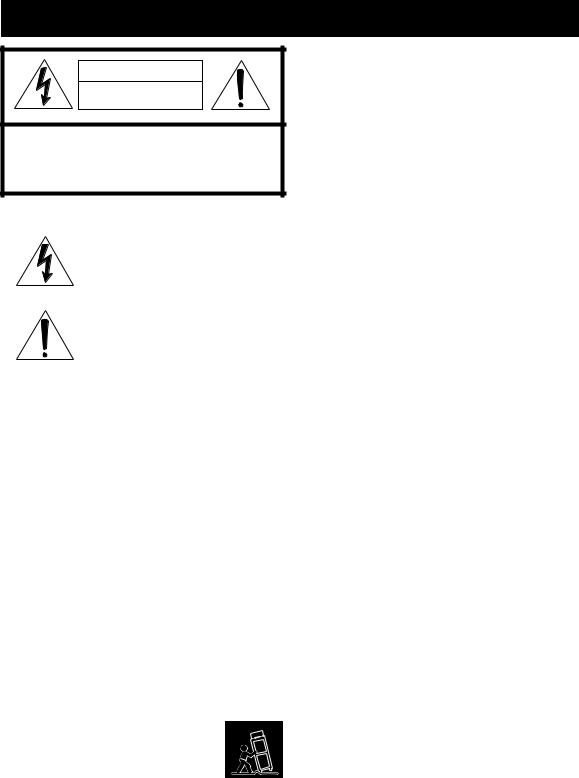
IMPORTANT SAFETY INSTRUCTIONS
CAUTION |
RISK OF ELECTRIC SHOCK |
DO NOT OPEN |
CAUTION: TO REDUCE THE RISK OF |
ELECTRIC SHOCK, DO NOT REMOVE |
COVER (OR BACK). NO USER-SERVICEABLE |
PARTS INSIDE. REFER SERVICING TO |
QUALIFIED SERVICE PERSONNEL. |
•Explanation of Graphical Symbols
The lightning flash with arrowhead symbol, within an equilateral triangle, is intended to alert you to the presence of uninsulated “dangerous voltage” within the product’s enclosure that may be of sufficient magnitude to constitute a risk of electric shock to persons.
The exclamation point within an equilateral triangle is intended to alert you to the presence of important operating and maintenance (servicing) instructions in the literature accompanying the appliance.
1Read Instructions – All the safety and operating instructions should be read before the product is operated.
2Retain Instructions – The safety and operating instructions should be retained for future reference.
3Heed Warnings – All warnings on the product and in the operating instructions should be adhered to.
4Follow Instructions – All operating and use instructions should be followed.
5Cleaning – Unplug this product from the wall outlet before cleaning. Do not use liquid cleaners or aerosol cleaners.
6Attachments – Do not use attachments not recommended by the product manufacturer as they may cause hazards.
7Water and Moisture – Do not use this product near water – for example, near a bath tub, wash bowl, kitchen sink, or laundry tub; in a wet basement; or near a swimming pool; and the like.
8Accessories – Do not place this product on an unstable cart, stand, tripod, bracket, or table. The product may fall, causing serious injury to a child or adult, and serious damage to the product. Use only with a cart, stand, tripod, bracket, or table recommended by the manufacturer, or sold with the product. Any mounting of the product should follow the manufacturer’s instructions, and should use a mounting accessory recommended by the manufacturer.
9A product and cart combination should be moved with care. Quick stops, excessive force, and uneven surfaces may cause the product and cart combination to
overturn.
10Ventilation – Slots and openings in the cabinet are provided for ventilation and to ensure reliable operation of the product and to protect it from overheating, and these openings must not be blocked or covered. The openings should never be blocked by placing the product on a bed, sofa, rug, or other similar surface. This product should not be placed in a built-in installation such as a bookcase or rack unless proper ventilation is provided or the manufacturer’s instructions have been adhered to.
11Power Sources – This product should be operated only from the type of power source indicated on the marking label. If you are not sure of the type of power supply to your home, consult your product dealer or local power company. For products intended to operate from battery power, or other sources, refer to the operating instructions.
12Grounding or Polarization – This product may be equipped with a polarized alternating current line plug (a plug having one blade wider than the other). This plug will fit into the power outlet only one way. This is a safety feature. If you are unable to insert the plug fully into the outlet, try reversing the plug. If the plug should still fail to fit, contact your electrician to replace your obsolete outlet. Do not defeat the safety purpose of the polarized plug.
13Power-Cord Protection – Power-supply cords should be routed so that they are not likely to be walked on or pinched by items placed upon or against them, paying particular attention to cords at plugs, convenience receptacles, and the point where they exit from the product.
14Lightning – For added protection for this product during a lightning storm, or when it is left unattended and unused for long periods of time, unplug it from the wall outlet and disconnect the antenna or cable system. This will prevent damage to the product due to lightning and power-line surges.
15Power Lines – An outside antenna system should not be located in the vicinity of overhead power lines or other electric light or power circuits, or where it can fall into such power lines or circuits. When installing an outside antenna system, extreme care should be taken to keep from touching such power lines or circuits as contact with them might be fatal.
16Overloading – Do not overload wall outlets, extension cords, or integral convenience receptacles as this can result in a risk of fire or electric shock.
17Object and Liquid Entry – Never push objects of any kind into this product through openings as they may touch dangerous voltage points or short-out parts that could result in a fire or electric shock. Never spill liquid of any kind on the product.
18Servicing – Do not attempt to service this product yourself as opening or removing covers may expose you to dangerous voltage or other hazards. Refer all servicing to qualified service personnel.
19Damage Requiring Service – Unplug this product from the wall outlet and refer servicing to qualified service personnel under the following conditions:
a)When the power-supply cord or plug is damaged,
b)If liquid has been spilled, or objects have fallen into the product,
c)If the product has been exposed to rain or water,
i

d)If the product does not operate normally by following the operating instructions. Adjust only those controls that are covered by the operating instructions as an improper adjustment of other controls may result in damage and will often require extensive work by a qualified technician to restore the product to its normal operation,
e)If the product has been dropped or damaged in any way, and
f)When the product exhibits a distinct change in
performance - this indicates a need for service.
20Replacement Parts – When replacement parts are required, be sure the service technician has used replacement parts specified by the manufacturer or have the same characteristics as the original part. Unauthorized substitutions may result in fire, electric shock, or other hazards.
21Safety Check – Upon completion of any service or repairs to this product, ask the service technician to perform safety checks to determine that the product is in proper operating condition.
22Wall or Ceiling Mounting – The unit should be mounted to a wall or ceiling only as recommended by the manufacturer.
23Heat – The product should be situated away from heat sources such as radiators, heat registers, stoves, or other products (including amplifiers) that produce heat.
Note to CATV system installer:
This reminder is provided to call the CATV system installer’s attention to Article 820-40 of the NEC that provides guidelines for proper grounding and, in particular, specifies that the cable ground shall be connected to the grounding system of the building, as close to the point of cable entry as practical.
IMPORTANT SAFETY INSTRUCTIONS
24Outdoor Antenna Grounding – If an outside antenna or cable system is connected to the product, be sure the antenna or cable system is grounded so as to provide some protection against voltage surges and built-up static charges. Article 810 of the National Electrical Code, ANSI/NFPA 70, provides information with regard to proper grounding of the mast and supporting structure, grounding of the lead-in wire to an antenna discharge unit, size of grounding conductors, location of antenna discharge unit, connection to grounding electrodes, and requirements for the grounding electrode.
EXAMPLE OF ANTENNA GROUNDING
MAST |
ANTENNA |
|
LEAD IN |
|
WIRE |
GROUND |
|
CLAMP |
|
|
ANTENNA |
|
DISCHARGE UNIT |
|
(NEC SECTION 810–20) |
ELECTRIC |
|
SERVICE |
|
EQUIPMENT |
GROUNDING CONDUCTORS |
|
|
|
(NEC SECTION 810–21) |
|
GROUND CLAMPS |
|
POWER SERVICE GROUNDING |
|
ELECTRODE SYSTEM |
|
(NEC ART 250. PART H) |
NEC – NATIONAL ELECTRICAL CODE |
|
FCC INFORMATION (for US customers)
1IMPORTANT NOTICE: DO NOT MODIFY THIS UNIT!
This product, when installed as indicated in the instructions contained in this manual, meets FCC requirements. Modifications not expressly approved by Yamaha may void your authority, granted by the FCC, to use the product.
2IMPORTANT: When connecting this product to accessories and/or another product use only high quality shielded cables. Cable/s supplied with this product MUST be used. Follow all installation instructions. Failure to follow instructions could void your FCC authorization to use this product in the USA.
3NOTE: This product has been tested and found to comply with the requirements listed in FCC Regulations, Part 15 for Class “B” digital devices. Compliance with these requirements provides a reasonable level of assurance that your use of this product in a residential environment will not result in harmful interference with other electronic devices.
This equipment generates/uses radio frequencies and, if not installed and used according to the instructions found in the users manual, may cause interference harmful to the operation of other electronic devices.
Compliance with FCC regulations does not guarantee that interference will not occur in all installations. If this product is found to be the source of interference, which can be determined by turning the unit “OFF” and “ON”, please try to eliminate the problem by using one of the following measures:
Relocate either this product or the device that is being affected by the interference.
Utilize power outlets that are on different branch (circuit breaker or fuse) circuits or install AC line filter/s.
In the case of radio or TV interference, relocate/reorient the antenna. If the antenna lead-in is 300 ohm ribbon lead, change the lead-in to coaxial type cable.
If these corrective measures do not produce satisfactory results, please contact the local retailer authorized to distribute this type of product. If you can not locate the appropriate retailer, please contact Yamaha Electronics Corp., U.S.A. 6660 Orangethorpe Ave, Buena Park, CA 90620.
The above statements apply ONLY to those products distributed by Yamaha Corporation of America or its subsidiaries.
ii
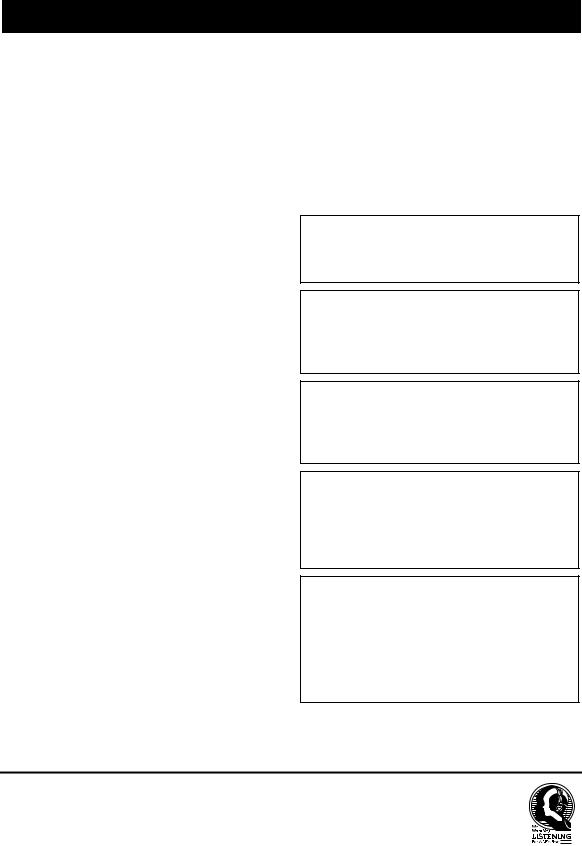
CAUTION: READ THIS BEFORE OPERATING YOUR UNIT.
1To assure the finest performance, please read this manual carefully. Keep it in a safe place for future reference.
2Install this sound system in a well ventilated, cool, dry, clean place – away from direct sunlight, heat sources, vibration, dust, moisture, and/or cold. Allow ventilation space of at least 30 cm on the top, 20 cm on the left and right, and 20 cm on the back of this unit.
3Locate this unit away from other electrical appliances, motors, or transformers to avoid humming sounds.
4Do not expose this unit to sudden temperature changes from cold to hot, and do not locate this unit in an environment with high humidity (i.e. a room with a humidifier) to prevent condensation inside this unit, which may cause an electrical shock, fire, damage to this unit, and/or personal injury.
5Avoid installing this unit where foreign objects may fall onto this unit and/or this unit may be exposed to liquid dripping or splashing. On the top of this unit, do not place:
–Other components, as they may cause damage and/or discoloration on the surface of this unit.
–Burning objects (i.e. candles), as they may cause fire, damage to this unit, and/or personal injury.
–Containers with liquid in them, as they may fall and liquid may cause electrical shock to the user and/or damage to this unit.
6Do not cover this unit with a newspaper, tablecloth, curtain, etc. in order not to obstruct heat radiation. If the temperature inside this unit rises, it may cause fire, damage to this unit, and/or personal injury.
7Do not plug in this unit to a wall outlet until all connections are complete.
8Do not operate this unit upside-down. It may overheat, possibly causing damage.
9Do not use force on switches, knobs and/or cords.
10When disconnecting the power cable from the wall outlet, grasp the plug; do not pull the cable.
11Do not clean this unit with chemical solvents; this might damage the finish. Use a clean, dry cloth.
12Only voltage specified on this unit must be used. Using this unit with a higher voltage than specified is dangerous and may cause fire, damage to this unit, and/or personal injury. YAMAHA will not be held responsible for any damage resulting from use of this unit with a voltage other than specified.
13To prevent damage by lightning, keep the power cord and outdoor antennas disconnected from a wall outlet or the unit during a lightning storm.
14Do not attempt to modify or fix this unit. Contact qualified YAMAHA service personnel when any service is needed. The cabinet should never be opened for any reasons.
15When not planning to use this unit for long periods of time (i.e. vacation), disconnect the AC power plug from the wall outlet.
16Install this unit near the AC outlet and where the AC power plug can be reached easily.
17Be sure to read the “TROUBLESHOOTING” section on common operating errors before concluding that this unit is faulty.
18Before moving this unit, press MASTER ON/OFF to release it outward to the OFF position to turn off this unit, the main room, Zone 2 and Zone 3 and then disconnect the AC power plug from the AC wall outlet.
WARNING
TO REDUCE THE RISK OF FIRE OR ELECTRIC SHOCK, DO NOT EXPOSE THIS UNIT TO RAIN OR MOISTURE.
As long as this unit is connected to the AC wall outlet, it is not disconnected from the AC power source even if you turn off this unit by MASTER ON/OFF. In this state, this unit is designed to consume a very small quantity of power.
FOR CANADIAN CUSTOMERS
To prevent electric shock, match wide blade of plug to wide slot and fully insert.
This Class B digital apparatus complies with Canadian ICES-003.
POUR LES CONSOMMATEURS CANADIENS
Pour éviter les chocs électriques, introduire la lame la plus large de la fiche dans la borne correspondante de la prise et pousser jusqu’au fond.
Cet appareil numérique de la classe B est conforme à la norme NMB-003 du Canada.
IMPORTANT
Please record the serial number of this unit in the space below.
MODEL:
Serial No.:
The serial number is located on the rear of the unit. Retain this Owner’s Manual in a safe place for future reference.
We Want You Listening For A Lifetime
YAMAHA and the Electronic Industries Association’s Consumer Electronics Group want you to get the most out of your equipment by playing it at a safe level. One that lets the sound come through loud and clear without annoying blaring or distortion – and, most importantly, without affecting your sensitive hearing. Since hearing damage from loud sounds is often undetectable until it is too late, YAMAHA and the Electronic Industries Association’s Consumer Electronics Group recommend you to avoid prolonged exposure from excessive volume levels.
iii

CONTENTS
INTRODUCTION |
|
FEATURES............................................................. |
2 |
GETTING STARTED............................................ |
3 |
Supplied accessories .................................................. |
3 |
Installing batteries in the remote controls.................. |
4 |
Handling the remote control ...................................... |
5 |
Opening and closing the front panel door.................. |
5 |
CONTROLS AND FUNCTIONS ......................... |
6 |
Front panel................................................................. |
6 |
Remote control........................................................... |
8 |
Zone 2/Zone 3 remote control ................................. |
10 |
Front panel display .................................................. |
11 |
Rear panel ................................................................ |
13 |
PREPARATION |
|
CONNECTIONS .................................................. |
14 |
Before connecting speakers ..................................... |
14 |
Connecting speakers ................................................ |
15 |
Using bi-wire and bi-AMP connections .................. |
19 |
Information on cables and jacks |
|
used for connections............................................ |
20 |
Connecting HDMI components............................... |
23 |
Connecting video components................................. |
24 |
Connecting audio components................................. |
27 |
Connecting the antennas .......................................... |
29 |
Connecting the power cable..................................... |
30 |
Turning on and off this unit ..................................... |
30 |
Setting the speaker impedance................................. |
31 |
AUTO SETUP....................................................... |
32 |
Introduction.............................................................. |
32 |
Optimizer microphone setup.................................... |
32 |
Using AUTO SETUP .............................................. |
33 |
BASIC OPERATION |
|
PLAYBACK.......................................................... |
36 |
Basic operations....................................................... |
36 |
Additional operations............................................... |
38 |
RECORDING ....................................................... |
45 |
FM/AM TUNING ................................................. |
46 |
Automatic tuning ..................................................... |
46 |
Manual tuning.......................................................... |
47 |
Automatic preset tuning........................................... |
47 |
Manual preset tuning ............................................... |
49 |
Selecting preset stations........................................... |
50 |
Exchanging preset stations ...................................... |
51 |
XM® SATELLITE RADIO TUNING ............... |
52 |
What is XM Satellite Radio? ................................... |
52 |
XM Satellite Radio connections .............................. |
52 |
XM Satellite Radio controls and functions.............. |
53 |
Activating XM Satellite Radio ................................ |
54 |
Selecting the XM Satellite Radio mode................... |
55 |
Using XM Satellite Radio search modes ................. |
56 |
Setting XM Satellite Radio preset channels ............ |
59 |
Displaying the XM Satellite Radio |
|
information .......................................................... |
60 |
SOUND FIELD PROGRAMS |
|
EDITING SOUND FIELD PARAMETERS |
......62 |
What is a sound field? ............................................. |
62 |
Changing parameter settings ................................... |
62 |
SOUND FIELD PROGRAM |
|
DESCRIPTIONS............................................... |
64 |
For movie/video sources.......................................... |
64 |
For music sources .................................................... |
66 |
SOUND FIELD PARAMETER |
|
DESCRIPTIONS............................................... |
67 |
SOUND FIELD PROGRAM |
|
SPEAKER LAYOUTS...................................... |
71 |
ADVANCED OPERATION |
|
MANUAL SETUP................................................. |
75 |
Using MANUAL SETUP........................................ |
77 |
Using BASIC MENU .............................................. |
78 |
Using SOUND MENU ............................................ |
81 |
Using INPUT MENU .............................................. |
83 |
Using OPTION MENU ........................................... |
85 |
ADVANCED OPERATIONS .............................. |
89 |
Selecting the OSD mode.......................................... |
89 |
Adjusting speaker levels .......................................... |
89 |
ADVANCED SETUP ............................................ |
90 |
Using ADVANCED SETUP ................................... |
90 |
REMOTE CONTROL FEATURES ................... |
92 |
Control area ............................................................. |
92 |
Controlling each component.................................... |
93 |
Setting remote control codes ................................... |
94 |
Using LEARN ......................................................... |
96 |
Using RE-NAME .................................................... |
98 |
Using MACRO ........................................................ |
99 |
Using CLEAR........................................................ |
101 |
ZONE 2/ZONE 3................................................. |
104 |
Connecting the Zone 2 and |
|
Zone 3 components ........................................... |
104 |
Selecting Zone 2 or Zone 3.................................... |
105 |
Controlling Zone 2 and Zone 3.............................. |
106 |
Using the control mode of |
|
Zone 2 and Zone 3............................................. |
107 |
HDMI ................................................................... |
108 |
What is HDMI? ..................................................... |
108 |
Setting the HDMI parameters................................ |
109 |
Basic HDMI operations ......................................... |
109 |
ADDITIONAL INFORMATION |
|
TROUBLESHOOTING ..................................... |
110 |
GLOSSARY......................................................... |
117 |
Audio information ................................................. |
117 |
Video information.................................................. |
119 |
Sound field program information .......................... |
119 |
Parametric equalizer information .......................... |
120 |
SPECIFICATIONS............................................. |
121 |
INTRODUCTION |
|
|
|
|
|
PREPARATION |
|
|
|
|
|
OPERATION |
BASIC |
|
|
|
|
PROGRAMS |
FIELD SOUND |
|
|
|
|
OPERATION |
ADVANCED |
|
|
|
|
INFORMATION |
ADDITIONAL |
|
|
1
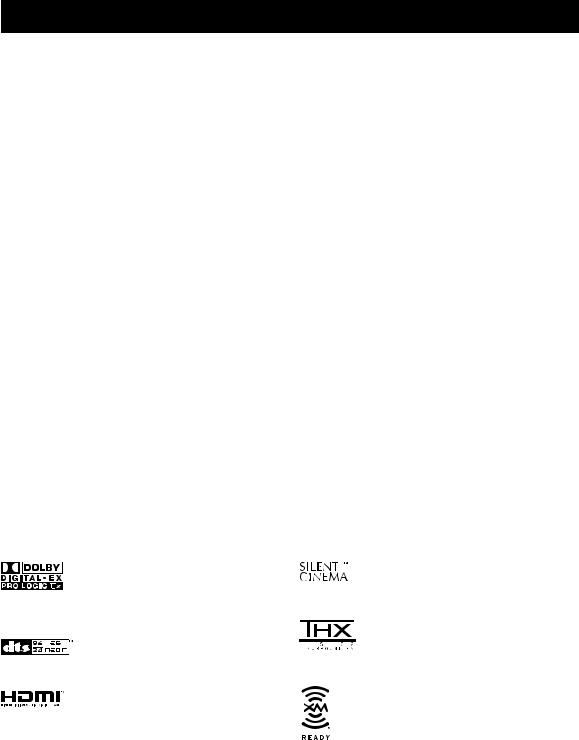
FEATURES
Built-in 7-channel power amplifier
Minimum RMS Output Power (0.04% THD, 20 Hz to 20 kHz, 8 Ω)
Front: 120 W + 120 W Center: 120 W
Surround: 120 W + 120 W Surround Back: 120 W + 120 W
Sound field features
Proprietary YAMAHA technology for the creation of sound fields
THX Select2
Dolby Digital/Dolby Digital EX decoder
DTS/DTS-ES Matrix 6.1, Discrete 6.1, DTS Neo:6 decoder, DTS 96/24
Dolby Pro Logic/Dolby Pro Logic  x decoder
x decoder
Virtual CINEMA DSP
SILENT CINEMA™
Sophisticated AM/FM tuner
40-station random access preset tuning
Automatic preset tuning
Preset station shifting capability (preset editing)
XM Satellite Radio (U.S.A. model only)
XM Satellite Radio tuning capability
HDMI (High-Definition Multimedia Interface)
HDMI interface for standard, enhanced or high-definition video as well as multi-channel digital audio
Analog video to HDMI digital video up-conversion (composite video ↔ S-video ↔ component video →
HDMI digital video) capability for monitor out
Other features
YPAO (YAMAHA Parametric Room Acoustic Optimizer) for automatic speaker setup
192-kHz/24-bit D/A converter
OSD (on-screen display) menus that allow you to optimize this unit to suit your individual audio/video system
6 or 8-channel additional input jacks for discrete multi-channel input
Short message function
PURE DIRECT for pure fidelity sound with analog and PCM sources
S-video input/output capability
Component video input/output capability
Analog video I/P conversion from 480i to 480p
Optical and coaxial digital audio signal jacks
Sleep timer
Cinema and music night listening mode
Remote control with preset remote control codes and learning/macro capability
Zone 2/Zone 3 custom installation facility
•yindicates a tip for your operation.
•Some operations can be performed by using either the buttons on the main unit or on the remote control. In cases when the button names differ between the main unit and the remote control, the button name on the remote control is given in parentheses.
•This manual is printed prior to production. Design and specifications are subject to change in part as a result of improvements, etc. In case of differences between the manual and product, the product has priority.
Manufactured under license from Dolby Laboratories. “Dolby”, “Surround EX”, and the double-D symbol are trademarks of Dolby Laboratories.
“DTS”, “DTS-ES”, “Neo:6” and “DTS 96/24” are trademarks of Digital Theater Systems, Inc.
“HDMI”, the “HDMI” logo and “High-Definition Multimedia Interface” are trademarks or registered trademarks of HDMI Licensing LLC.
“SILENT CINEMA” is a trademark of YAMAHA CORPORATION.
The THX logo is a trademark of THX Ltd. which may be registered in some jurisdictions. All rights reserved.
© 2005 XM Satellite Radio Inc. All rights reserved. All other trademarks are the property of their respective owners.
2
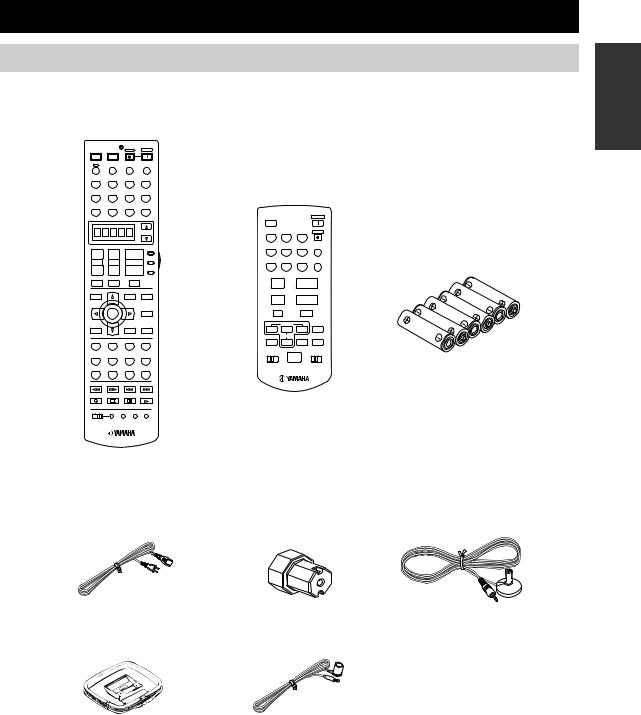
GETTING STARTED
Supplied accessories
Please check that you received all of the following parts.
Remote control
POWER |
POWER |
STANDBY |
POWER |
|
|
|
|
TV |
AV |
|
|
|
|
|
|
A |
XM |
AUDIO SEL |
SLEEP |
|
|
|
|
PHONO |
TUNER |
CD |
MULTI CH IN |
Zone 2/Zone 3 |
|||
|
|
|
|
||||
V-AUX |
CBL/SAT |
MD/TAPE |
CD-R |
remote control |
|||
DTV |
VCR 1 |
DVR/VCR2 |
DVD |
|
|
|
|
|
|
|
|
XM |
|
|
POWER |
|
|
|
SELECT |
TUNER |
CD |
CD-R |
STANDBY |
|
|
|
|
1 |
2 |
3 |
|
|
|
|
|
DTV |
CBL/SAT MD/TAPE |
PHONO |
|
+ |
+ |
+ |
AMP |
4 |
5 |
6 |
ENT |
|
|||||||
|
|
|
|
|
|||
TV VOL |
CH |
|
SOURCE |
VCR1 DVR/VCR2 |
DVD |
V-AUX |
|
VOLUME |
7 |
8 |
9 |
|
|||
– |
– |
– |
TV |
0 |
|||
|
|
|
|
||||
TV MUTE |
TV INPUT |
MUTE |
|
+ |
|
+ |
|
LEVEL |
PRESET/CH |
SET MENU |
PURE DIRECT |
PRESET |
VOLUME |
||
|
|||||||
TITLE |
|
MENU |
|
– |
|
– |
|
BAND |
|
SRCH MODE |
|
|
|
||
|
|
|
NIGHT |
A/B/C/D/E |
|
|
|
|
ENTER |
|
AUDIO |
|
|
MUTE |
|
A-E/CAT. |
|
|
|
|
|
|
|
|
|
ON SCREEN |
STRAIGHT |
|
A-E/CAT. |
|
|
RETURN |
|
DISPLAY |
|
k |
k |
k |
DISPLAY |
XM MEMORY |
|
|
EFFECT |
|
PRESET/CH |
|
|
STEREO |
MUSIC |
ENTERTAIN |
MOVIE |
ALL |
k |
PRESET |
CAT. |
1 |
2 |
3 |
4 |
|
|
|
|
THX |
STANDARD |
SELECT |
EXTD SUR. |
ID1 ID2 |
|
ZONE 2 ZONE 3 |
|
|
NUMBER |
|
|||||
5 |
6 |
7 |
8 |
|
|
|
|
1 MEMORY 2 |
A SPEAKERS B |
|
|
|
|
||
9 |
0 |
+10 |
ENT. |
|
|
|
|
REC |
|
|
|
|
|
|
|
DISC SKIP |
|
|
|
|
|
|
|
OFF ON |
MACRO LEARN CLEAR RE–NAME |
|
|
|
|
||
Batteries (x6)
(AAA, R03)
Power cable |
Speaker terminal |
Optimizer microphone |
|
wrench |
|
AM loop antenna |
Indoor FM antenna |
INTRODUCTION
3
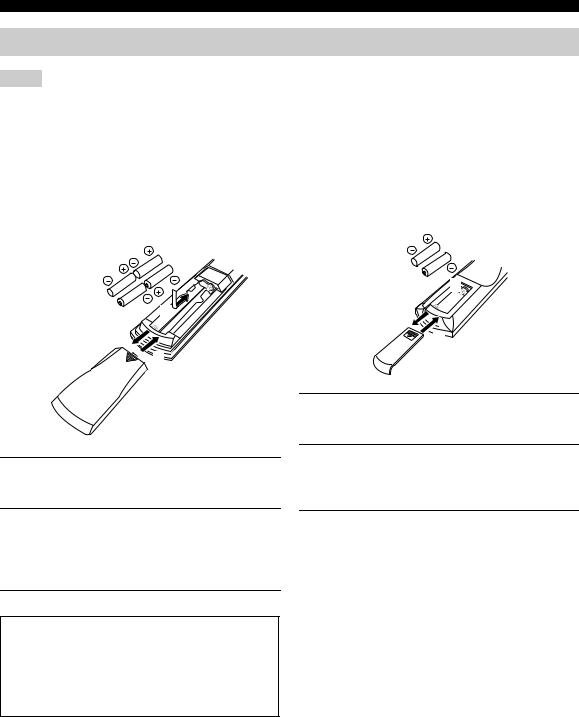
GETTING STARTED
Installing batteries in the remote controls
Notes
•Change all of the batteries if you notice conditions such as the operation range of the remote control decreases, the indicator does not flash, or its light or display window become dim.
•Do not use old batteries together with new ones.
•Do not use different types of batteries (such as alkaline and manganese batteries) together. Read the packaging carefully as these different types of batteries may have the same shape and color.
•If the batteries have leaked, dispose of them immediately. Avoid touching the leaked material or letting it come into contact with clothing, etc. Clean the battery compartment thoroughly before installing new batteries.
•Do not throw away batteries with general house waste; dispose of them correctly in accordance with your local regulations.
■ Installing batteries |
■ Zone 2/Zone 3 remote control |

 2 1
2 1
3
1Press the  part and slide the battery compartment cover off.
part and slide the battery compartment cover off.
2Insert four supplied batteries
(AAA, R03) according to the polarity markings on the inside of the battery compartment.
3Slide the cover back until it snaps into place.
If the remote control is without batteries for more than 2 minutes, or if exhausted batteries remain in the remote control, the contents of the memory may be cleared. When the memory is cleared, insert new batteries, set up the remote control code and program any acquired functions that may have been cleared.

 2 1
2 1 
3
1Press the  part and slide the battery compartment cover off.
part and slide the battery compartment cover off.
2Insert two supplied batteries (AAA, R03) according to the polarity markings (+ and –) on the inside of the battery compartment.
3Slide the cover back until it snaps into place.
4
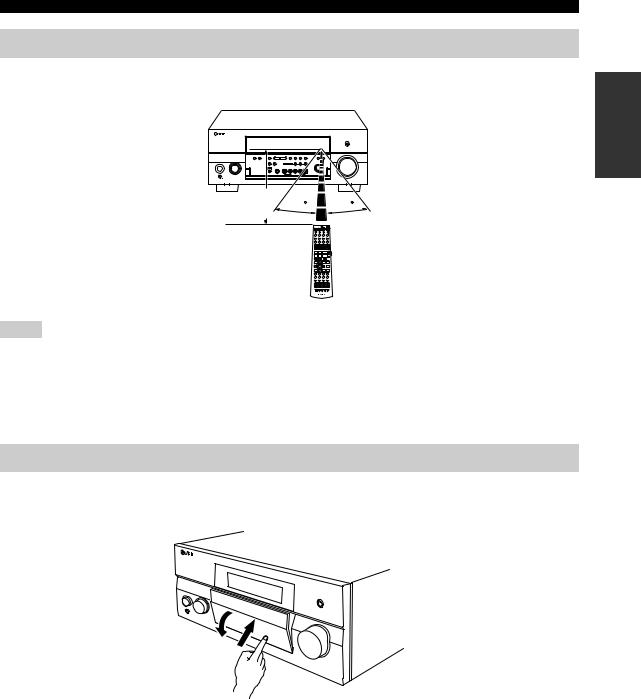
GETTING STARTED
Handling the remote control
The remote control transmits a directional infrared ray.
Be sure to aim the remote control directly at the remote control sensor on the main unit during operation.
Approximately 6 m (20 ft)
30 30
+ + +
– – –
INTRODUCTION
Notes
•Do not spill water or other liquids on the remote control.
•Do not drop the remote control.
•Do not leave or store the remote control in the following types of conditions:
–places of high humidity, such as near a bath
–places of high temperatures, such as near a heater or stove
–extremely low temperatures
–dusty places
Opening and closing the front panel door
When you want to use the controls behind the front panel door, open the door by gently pressing on the lower part of the panel. Keep the door closed when not using these controls.
To open, press gently on the lower part of the panel.
5
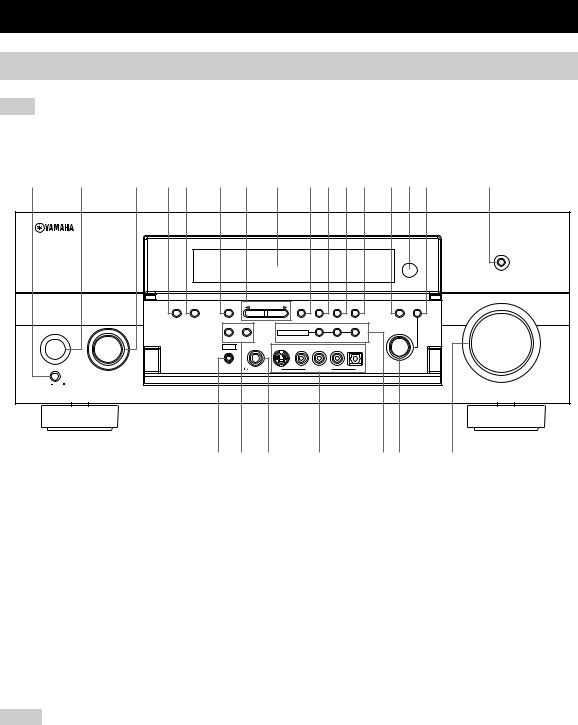
CONTROLS AND FUNCTIONS
Front panel
Note
The XM Satellite Radio controls (SEARCH MODE, CATEGORY, PRESET/TUNING/CH l/ h, MEMORY and DISPLAY) are only applicable to the U.S.A. model and are operational only when XM is selected as the input source. For details, see “Front panel functions” on page 53.
1 |
2 |
3 4 5 6 7 8 9 0 A B C D E |
F |
||||||||||
|
|
|
|
|
|
|
|
|
|
|
|
|
PURE DIRECT |
|
|
|
|
|
|
|
|
|
|
|
|
|
VOLUME |
|
|
AUDIO |
MULTI CH |
|
|
|
PRESET/ |
|
|
|
TUNING |
TONE |
|
|
|
SELECT |
INPUT |
A/B/C/D/E |
PRESET/TUNING/CH |
TUNING |
FM/AM |
MEMORY |
MODE |
STRAIGHT CONTROL |
|
||
|
|
|
|
|
|
|
EDIT |
|
|
|
|
|
|
MAIN ZONE |
INPUT |
|
CATEGORY |
|
|
SEARCH MODE |
DISPLAY |
MAN'L/AUTO FM |
AUTO/MAN'L |
EFFECT |
|
||
|
|
|
|
|
|
|
|
|
|
|
|||
|
|
|
|
SPEAKERS |
|
|
ZONE ON/OFF |
ZONE CONTROL |
|
|
|||
|
|
|
|
|
|
MULTI ZONE |
|
|
|
|
PROGRAM |
|
|
|
|
|
|
|
|
|
|
|
|
|
|
||
|
|
|
|
A |
B |
|
|
ZONE 2 |
ZONE 3 |
|
|
|
|
|
ON/OFF |
|
|
YPAO |
SILENT CINEMA |
S VIDEO |
VIDEO |
L AUDIO R |
|
OPTICAL |
|
|
|
|
|
|
|
|
|
|
|
|
|
|
|
|
|
MASTER |
|
|
OPTIMIZER |
PHONES |
|
|
|
|
|
|
|
|
|
|
|
MIC |
|
VIDEO/AUX |
|
|
|
|
|||||
ON |
OFF |
|
|
|
|
|
|
|
|
|
|
|
|
(U.S.A. model)
G H I |
J |
K L |
M |
1 MASTER ON/OFF |
4 AUDIO SELECT |
|
|
Press inward to the ON position.
•Turns on this unit.
•Turns on the main room.
•Sets Zone 2 and Zone 3 to the standby mode. Press again to release it outward to the OFF position.
•Turns off this unit.
•Turns off the main room, Zone 2 and Zone 3. See page 30 for details.
2 MAIN ZONE ON/OFF
Turns on this unit only or sets it to the standby mode.
y
In the standby mode, this unit consumes a small quantity of power.
Notes
•When you turn on this unit, there will be a 6 to 7 second delay before this unit can reproduce sound.
•This button is operational only when MASTER ON/OFF is pressed inward to the ON position.
3 INPUT selector
Selects the desired input source.
Toggles the priority for the type of audio input jack between AUTO, HDMI, COAX/OPT and ANALOG when one component is connected to two or more input jacks on the rear panel (see page 43).
5 MULTI CH INPUT
Selects the input source connected to the MULTI CH INPUT jacks. When selected, the MULTI CH INPUT source takes priority over the input source selected with the INPUT selector (or the input selector buttons on the remote control).
6 A/B/C/D/E
Selects one of the 5 preset station groups (A to E) when TUNER is selected as the input source (see page 50).
7 PRESET/TUNING/CH l / h
Selects the preset station number (1 to 8) when TUNER is selected as the input source and the colon (:) is displayed next to the band indication in the front panel display.
Selects the tuning frequency when TUNER is selected as the input source and the colon (:) is not displayed in the front panel display.
See pages 46 to 51 for details.
6

8 Front panel display
Shows information about the operational status of this unit.
9 PRESET/TUNING (EDIT)
Switches the function of PRESET/TUNING/CH l/ h between selecting preset station numbers and tuning when TUNER is selected as the input source (see pages 46 to 51).
0 FM/AM
Switches the reception band (FM or AM) when TUNER is selected as the input source (see page 46).
Note
The frequency of the previously received station is automatically recalled.
A MEMORY (MAN’L/AUTO FM)
Stores a station in the memory when TUNER is selected as the input source. Hold down for more than 3 seconds to start automatic preset tuning (see page 47).
BTUNING MODE (AUTO/MAN’L), DISPLAY
Switches the tuning mode between automatic (the AUTO indicator is turned on) and manual (the AUTO indicator is turned off) when TUNER is selected as the input source.
CSTRAIGHT (EFFECT)
Turns the sound field programs on or off. When STRAIGHT is selected, 2-channel or multi-channel input signals are output directly from the respective speakers without effect processing.
D Remote control sensor
Receives infrared signals from the remote control.
E TONE CONTROL
Use to adjust the balance of bass and treble for the front left and right and center channels (see page 38).
F PURE DIRECT
Turns on or off the PURE DIRECT mode (see page 41).
Note
The indicator around the button lights up when the unit is in the PURE DIRECT mode.
G OPTIMIZER MIC jack
Use to connect the supplied optimizer microphone to run AUTO SETUP (see page 32).
H SPEAKERS A/B
Turn on or off the set of front speakers connected to the SPEAKERS A and/or B terminals on the rear panel each time the corresponding button is pressed.
CONTROLS AND FUNCTIONS
I  PHONES (SILENT CINEMA) jack
PHONES (SILENT CINEMA) jack
Outputs audio signals for private listening with headphones.
Notes
•When you connect headphones, no signals are output at the PRE OUT jacks or to the speakers.
•All Dolby Digital and DTS audio signals are mixed down to 2- channel stereo (front left and right channels).
J VIDEO AUX jacks
Input audio and video signals from an external source such as a game console. To reproduce source signals at these jacks, select V-AUX as the input source.
KMULTI ZONE buttons
ZONE 2 ON/OFF
Turns on Zone 2 only or sets it to the standby mode. See page 30 for details.
Note
This button is operational only when MASTER ON/OFF is pressed inward to the ON position.
ZONE 3 ON/OFF
Turns on Zone 3 only or sets it to the standby mode. See page 30 for details.
Note
This button is operational only when MASTER ON/OFF is pressed inward to the ON position.
ZONE CONTROL
Switches the zone you want to control between the main unit, Zone 2 and Zone 3 (see page 106).
After you press ZONE CONTROL, the indicator for the currently selected zone flashes in the front panel display for approximately 5 seconds. While the indicator is flashing, perform the desired operation.
L PROGRAM selector
Use to select sound field programs or adjust the balance of bass and treble in conjunction with TONE CONTROL.
M VOLUME
Controls the volume level of all audio channels.
Note
This does not affect the OUT (REC) level.
INTRODUCTION
7
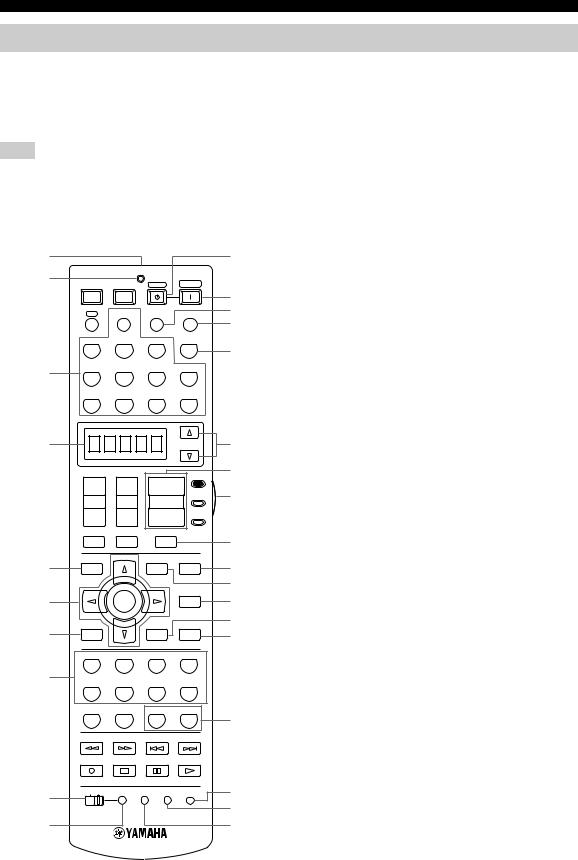
CONTROLS AND FUNCTIONS
Remote control
This section describes the function of each control on the remote control used to control this unit. Set AMP/ SOURCE/TV to AMP to operate this unit. To operate other components, see “REMOTE CONTROL FEATURES” on page 92.
Note
The XM Satellite Radio controls (XM, XM MEMORY, SRCH MODE, DISPLAY, cursor buttons k/ n/ l/ h, numeric buttons and ENT.) are only applicable to the U.S.A. model and are operational only when XM is selected as the input source. For details, see “Remote control functions” on page 53.
1 |
|
|
|
|
|
|
A |
2 |
POWER |
POWER |
STANDBY |
POWER |
|
||
|
|
||||||
|
TV |
|
AV |
|
|
|
B |
|
A |
|
XM |
AUDIO SEL |
SLEEP |
C |
|
|
|
|
|
|
|
|
D |
|
PHONO |
TUNER |
CD |
MULTI CH IN |
E |
||
|
|
|
|
|
|
|
|
3 |
V-AUX |
CBL/SAT |
MD/TAPE |
CD-R |
|
||
|
DTV |
|
VCR 1 |
DVR/VCR2 |
DVD |
|
|
4 |
|
|
|
|
|
SELECT |
F |
|
|
|
|
|
|
AMP |
G |
|
+ |
|
+ |
|
+ |
|
|
|
|
|
|
H |
|||
|
TV VOL |
CH |
|
|
SOURCE |
||
|
VOLUME |
|
|||||
|
– |
|
– |
|
– |
TV |
|
|
TV MUTE |
TV INPUT |
|
MUTE |
|
I |
|
5 |
LEVEL |
PRESET/CH |
SET MENU |
PURE DIRECT |
J |
||
TITLE |
|
MENU |
|
||||
|
BAND |
|
SRCH MODE |
|
K |
||
6 |
|
|
|
|
|
NIGHT |
L |
|
|
ENTER |
|
|
AUDIO |
||
|
A-E/CAT. |
|
|
|
|
M |
|
7 |
|
|
|
ON SCREEN |
STRAIGHT |
N |
|
RETURN |
|
DISPLAY |
|
||||
|
XM MEMORY |
|
|
|
EFFECT |
|
|
|
STEREO |
MUSIC |
ENTERTAIN |
MOVIE |
|
||
8 |
1 |
|
2 |
3 |
|
4 |
|
THX |
|
STANDARD |
SELECT |
EXTD SUR. |
|
||
|
|
|
|||||
|
5 |
|
6 |
7 |
|
8 |
|
|
1 |
MEMORY 2 |
A |
SPEAKERS B |
O |
||
|
9 |
|
0 |
+10 |
ENT. |
||
|
FREQ/TEXT |
EON |
MODE |
PTY SEEK START |
|
||
|
REC |
|
|
|
|
|
|
|
DISC SKIP |
|
|
|
|
P |
|
9 |
OFF |
ON |
MACRO LEARN |
CLEAR RE–NAME |
|||
|
|
|
|
|
|
Q |
|
|
|
|
|
|
|
|
|
0 |
|
|
|
|
|
|
R |
(U.S.A. model)
1 Infrared window
Outputs infrared control signals. Aim this window at the component you want to operate.
2 Transmission indicator
Flashes while the remote control is sending infrared signals.
3 Input selector buttons
Select the input source and change the control area. Set AMP/SOURCE/TV to SOURCE and then press TUNER to select TUNER as the input source.
Set AMP/SOURCE/TV to SOURCE and then press XM to select XM as the input source.
4 Display window
Shows the name of the selected input source that you can control.
5 LEVEL, BAND
Selects the speaker you want to adjust the speaker output level for when AMP/SOURCE/TV is set to AMP
(see pages 89).
Switches the reception band between FM and AM when AMP/SOURCE/TV is set to SOURCE and TUNER is selected as the input source.
6 Cursor buttons k / n / l / h, ENTER
Selects and adjusts the DSP program parameters or OSD menu items when AMP/SOURCE/TV is set to AMP. Press l/ hto select a preset station group (A to E) and k/ nto select a preset station number (1 to 8) when AMP/SOURCE/TV is set to SOURCE and TUNER is selected as the input source.
7 RETURN
Returns to the upper or the previous directory in the OSD menu.
8Sound field program / numeric buttons
Select sound field programs when AMP/SOURCE/TV is set to AMP.
Use SELECT to play back 2-channel sources in the multichannel format (see page 40).
Use EXTD SUR. to switch between 5.1 and 6.1/7.1 channel playback of multi-channel software (see page 39). Use numbers 1 to 8 to select preset stations when AMP/ SOURCE/TV is set to SOURCE and TUNER is selected as the input source.
9MACRO ON/OFF
Turns on or off the macro function (see page 100).
0 MACRO
Programs a series of operations to be controlled with a single button (see page 99).
8

A STANDBY
Sets this unit, Zone 2 and Zone 3 to the standby mode (see page 30).
Note
This button is operational only when MASTER ON/OFF on the front panel is pressed inward to the ON position.
B POWER
Turns on this unit, Zone 2 and Zone 3 (see page 30).
Note
This button is operational only when MASTER ON/OFF on the front panel is pressed inward to the ON position.
C AUDIO SEL
Toggles the priority for the type of audio input jack between AUTO, HDMI, COAX/OPT and ANALOG when one component is connected to two or more input jacks on the rear panel (see page 43).
D SLEEP
Sets the sleep timer.
E MULTI CH IN
Selects MULTI CH INPUT when using an external decoder, etc.
F SELECT k / n
Selects another input source that you can control independently of the input source selected with the input selector buttons.
G VOLUME +/–
Increases or decreases the volume level.
H AMP/SOURCE/TV
Selects the component you want to control with the remote control.
AMP
Set to this position to operate this unit.
SOURCE
Set to this position to operate the component selected with an input selector button.
TV
Set to this position to operate the television assigned to either DTV or PHONO.
Note
If televisions are assigned to both DTV and PHONO, the one assigned to DTV takes priority and gets operated when AMP/ SOURCE/TV is set to TV.
y
To set the remote control codes for other components, see page 94.
I MUTE
Mutes the sound. Press again to restore the audio output to the previous volume level.
CONTROLS AND FUNCTIONS
J PURE DIRECT
Turns on or off the PURE DIRECT mode (see page 41).
K SET MENU
Enters or exits the SET MENU mode.
L NIGHT
Turns on or off the night listening modes (see page 41).
M ON SCREEN
Selects the display mode of the on-screen display (OSD) that appears on your monitor (see page 89).
N STRAIGHT (EFFECT)
Switches the sound field programs off or on. When STRAIGHT is selected, 2-channel or multi-channel input signals are output directly from their respective speakers without effect processing.
O SPEAKERS A/B
Turns on or off the set of front speakers connected to the SPEAKERS A and/or B terminals on the rear panel each time the corresponding button is pressed.
P RE-NAME
Changes the name of the input source in the display window (see page 98).
Q CLEAR
Clears remote control codes or functions acquired from the learn, macro and rename features (see page 101).
R LEARN
Programs remote control codes or functions from other remote controls (see page 96).
INTRODUCTION
9
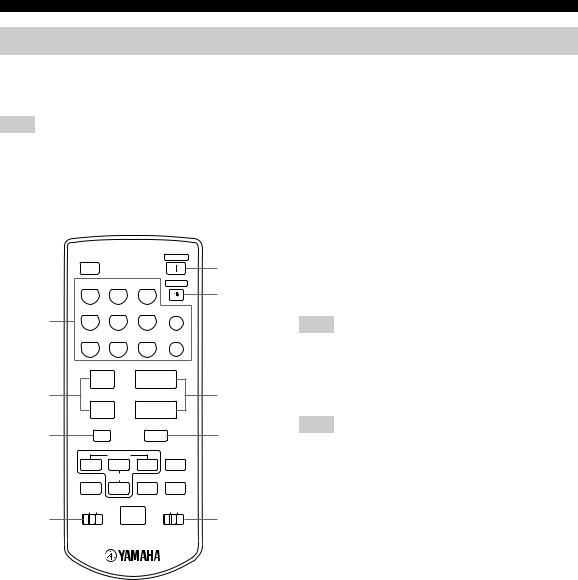
CONTROLS AND FUNCTIONS
Zone 2/Zone 3 remote control
This section describes the function of each control on the Zone 2/Zone 3 remote control used to control Zone 2 or Zone 3.
Note
The XM Satellite Radio controls (XM, DISPLAY, PRESET, ALL, CAT., numeric buttons, NUMBER, cursor buttons
k/ n/ l/ hand ENT) are only applicable to the U.S.A. model and are operational only when XM is selected as the input source. For details, see “Zone 2/Zone 3 remote control functions” on page 54.
|
XM |
|
|
POWER |
|
|
|
|
|
|
5 |
|
TUNER |
CD |
CD-R |
STANDBY |
|
|
1 |
2 |
3 |
|
6 |
|
DTV |
CBL/SAT MD/TAPE |
PHONO |
||
1 |
4 |
5 |
6 |
|
ENT |
|
VCR1 |
DVR/VCR2 |
DVD |
V-AUX |
|
|
7 |
8 |
9 |
|
0 |
|
+ |
+ |
|
|
|
2 |
PRESET |
VOLUME |
7 |
||
|
– |
– |
|
|
|
|
A/B/C/D/E |
|
|
|
|
3 |
|
|
MUTE |
|
8 |
|
|
A-E/CAT. |
|
|
|
|
k |
k |
k |
DISPLAY |
|
|
|
PRESET/CH |
|
|
|
|
ALL |
k |
PRESET |
CAT. |
|
|
ID1 ID2 |
|
ZONE 2 |
ZONE 3 |
|
4 |
|
NUMBER |
|
9 |
|
|
|
|
|
||
(U.S.A. model)
1 Input selector buttons
Select the desired input source of Zone 2 or Zone 3 and change the control area.
2 PRESET +/–
Selects the preset station number (1 to 8) when TUNER is selected as the input source or Zone 2 or Zone 3.
3 A/B/C/D/E
Selects the preset station group (A to E) when TUNER is selected as the input source or Zone 2 or Zone 3.
4 ID1/ID2 switch
Switches the remote control ID between ID1 and ID2 (see page 95).
5 POWER
Turns on Zone 2 or Zone 3.
Note
This button is operational only when MASTER ON/OFF on the front panel is pressed inward to the ON position.
6 STANDBY
Sets Zone 2 or Zone 3 to the standby mode.
Note
This button is operational only when MASTER ON/OFF on the front panel is pressed inward to the ON position.
7 VOLUME +/–
Increases or decreases the volume level or Zone 2 or Zone 3.
8 MUTE
Mutes the sound of Zone 2 or Zone 3.
Press again to restore the audio output to the previous volume level.
9 ZONE 2/ZONE 3 switch
Switches between the operation mode of Zone 2 and that of Zone 3.
10
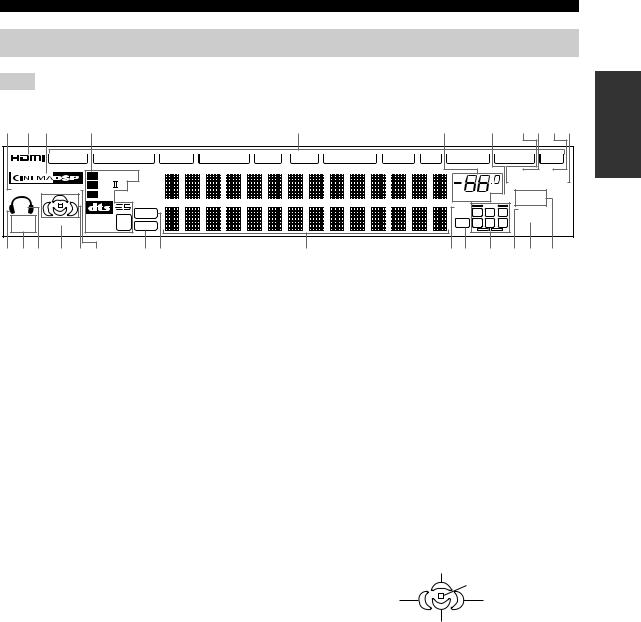
CONTROLS AND FUNCTIONS
Front panel display
Note
The XM indicator is only applicable to the U.S.A. model.
1 2 3 |
4 |
|
|
|
|
|
5 |
|
6 |
7 |
8 9 0 A |
|
|
V-AUX |
DVR/VCR 2 |
VCR 1 |
CBL/SAT |
DTV |
DVD |
MD/TAPE |
CD-R CD |
PHONO TUNER XM |
|||
|
|
DIGITAL |
|
|
|
|
|
|
|
STEREO TUNED |
||
YPAO HiFi DSP |
PL |
x |
CS |
|
|
|
|
|
|
dB |
AUTO MEMORY |
|
EX |
|
|
|
|
|
|
|
ZONE2 |
||||
SP |
|
|
|
|
|
|
|
|
|
VOLUME MUTE |
||
|
|
|
|
|
|
|
|
|
|
96/24 |
ZONE3 |
|
A B |
|
|
|
DSD |
|
|
|
|
|
|
NIGHT |
|
|
DISCRETE 96 |
|
|
|
|
|
|
L C R |
||||
SILENT |
VIRTUAL |
PCM |
|
|
|
|
|
|
LFE SL SB SR |
SLEEP |
||
CINEMA |
MATRIX |
24 |
|
|
|
|
|
|
|
|||
|
|
|
|
|
|
|
|
|
||||
B C D E F G |
|
H I |
|
|
J |
|
KL M N O P |
|||||
1 YPAO indicator
Lights up when the AUTO SETUP procedure is in progress and when the AUTO SETUP speaker settings are used without any modifications.
2 HDMI indicator
Lights up when HDMI components are assigned to HDMI IN 1 and HDMI IN 2 jacks and they are recognized by this unit (see page 83).
Turns off when no HDMI component is assigned to the either HDMI IN 1 or HDMI IN 2 jack or when no HDMI component is recognized by this unit although they are assigned to the HDMI IN jacks (see page 83).
See page 108 for details.
3 CINEMA DSP indicator
Lights up when you select a CINEMA DSP sound field program.
4 Decoder indicators
When any of the decoders of this unit operate, the respective indicator lights up.
5 Input source indicators
Light up when the corresponding input source is selected.
6VOLUME level indicator
Indicates the volume level.
7MUTE indicator
Flashes while the MUTE function is on.
8 AUTO indicator
Lights up when this unit is in the automatic tuning mode.
9 STEREO indicator
Lights up when this unit is receiving a stereo signal for an FM stereo broadcast while the AUTO indicator is lit.
0 TUNED indicator
Lights up when this unit is tuned into a station.
A MEMORY indicator
Flashes to indicate that a station can be stored.
B Headphones indicator
Lights up when headphones are connected.
C SILENT CINEMA indicator
Lights up when headphones are connected and a sound field program is selected (see page 38).
D SP A B indicators
Light up according to the set of front speakers selected. Both indicators light up when both sets of front speakers are selected or when bi-wiring.
E VIRTUAL indicator
Lights up when Virtual CINEMA DSP is active (see page 43).
F Sound field indicators
Light up to indicate the active DSP sound fields.
Presence DSP sound field
|
Listening position |
Left surround |
Right surround |
DSP sound field |
DSP sound field |
Surround/surround back DSP sound field
G HiFi DSP indicator
Lights up when you select a HiFi DSP sound field program.
H PCM indicator
Lights up when this unit is reproducing PCM (pulse code modulation) digital audio signals.
I DSD indicator
Lights up when this unit is reproducing DSD (direct stream digital) digital audio signals.
J Multi-information display
Shows the name of the current sound field program and other information when adjusting or changing settings.
INTRODUCTION
11

CONTROLS AND FUNCTIONS
K 96/24 indicator
Lights up when a DTS 96/24 signal is input to this unit.
L LFE indicator
Lights up when the input signal contains an LFE signal.
MInput channel and speaker indicators
Input channel indicators
Indicate the channel components of the current digital input signal.
L C R
SL SB SR
Presence and surround back speaker indicators
Light up according to the number of presence and surround back speakers set for PRESENCE SP (see page 79) and SB L/R SP (see page 79) in
MANUAL SETUP when TEST TONE in MANUAL SETUP is set to ON (see page 81).
y
You can make settings for the presence and surround back speakers automatically by running AUTO SETUP
(see page 32) or manually by adjusting settings for PRESENCE SP (see page 79) and SB L/R SP (see page 79) in MANUAL SETUP.
N NIGHT indicator
Lights up when you select a night listening mode.
O SLEEP indicator
Lights up while the sleep timer is on.
P ZONE 2/ZONE 3 indicators
Light up when Zone 2 or Zone 3 is turned on.
12
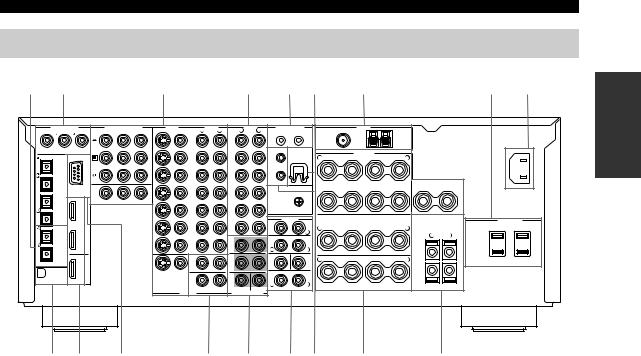
CONTROLS AND FUNCTIONS
Rear panel
1 |
2 |
|
|
|
|
3 |
|
|
|
4 |
|
|
5 |
6 |
|
|
7 |
|
|
|
8 |
9 |
|
DIGITAL INPUT |
COMPONENT VIDEO |
VIDEO |
|
AUDIO |
AUDIO |
|
CONTROL OUT |
|
|
TUNER |
|
|
|
|
|
||||||||
|
|
COAXIAL |
Y |
PB |
PR |
S VIDEO |
VIDEO |
R |
L |
R |
L |
+12V 15mA MAX. |
FM ANT |
|
GND |
|
AM ANT |
|
|
||||
|
|
|
DVD |
|
|
|
|
|
|
(PLAY) |
|
75Ω |
|
|
|
|
|
|
AC IN |
||||
|
|
|
|
|
|
|
|
|
IN |
|
|
|
|
|
|
|
|
|
|
|
|||
|
|
|
|
|
|
|
|
DVD |
|
|
1 |
|
2 |
|
UNBAL. |
|
|
|
|
|
|
|
|
|
|
|
|
|
|
|
|
|
|
|
|
|
|
|
|
|
|
|
|
|
|||
CD |
DVD |
DVR/ |
|
|
|
|
|
|
|
MD/TAPE |
|
REMOTE |
WRENCH |
|
|
|
|
|
|
|
|
||
|
|
VCR 2 |
DTV |
|
|
|
|
|
|
|
|
|
|
HOLDER |
+ |
– |
SPEAKERS |
– |
+ |
|
|
|
|
CD |
OPTICAL |
|
|
|
|
|
|
DTV |
|
|
|
IN |
|
|
R |
A |
L |
|
|
||||
|
|
|
|
|
|
|
OUT |
|
|
|
|
|
|
|
|
|
|||||||
|
|
|
CBL/ |
|
|
|
|
|
|
(REC) |
|
|
|
|
|
|
|
|
|
|
|
|
|
|
|
|
|
|
|
|
|
|
(PLAY) |
|
|
|
|
|
|
|
|
|
|
|
|
|
|
|
|
|
SAT |
|
|
|
|
CBL/ |
|
IN |
|
|
|
|
|
|
|
|
|
|
|
|
|
DVD |
|
|
|
|
|
|
|
|
|
|
OUT |
|
|
|
|
|
|
|
|
|
|
|
|
|
|
|
|
|
|
|
SAT |
|
|
|
|
|
|
|
|
|
|
|
|
|
|
||
|
|
|
|
|
|
|
|
|
|
CD-R |
|
|
|
|
FRONT |
|
B |
|
|
CENTER |
|
|
|
DTV |
|
|
|
|
|
|
|
IN |
|
|
|
|
|
|
|
+ |
– |
– |
+ |
– |
+ |
|
|
|
RS-232C |
|
|
|
|
|
|
|
|
|
|
|
|
|
|
|
|
|
|
|
|
||
|
|
|
|
|
|
|
|
|
|
OUT |
|
|
|
|
|
|
|
|
|
|
|
|
|
|
|
IN 1 |
|
MONITOR OUT |
|
|
|
VCR 1 |
|
(REC) |
|
GND |
|
|
|
|
|
|
|
|
|
|
|
CBL/SAT |
|
|
|
|
|
|
|
OUT |
|
CD |
|
|
|
|
|
|
|
|
|
|
|
|
|
|
|
|
|
|
|
|
|
|
|
PHONO |
|
|
PRE OUT |
|
|
|
|
|
|
SPEAKER IMPEDANCE |
AC OUTLETS |
||
|
|
|
|
|
|
|
|
|
|
|
FRONT |
|
|
|
|
|
|
|
|
||||
|
|
|
|
|
|
|
|
|
|
|
|
|
|
|
SURROUND/ZONE 2(3) |
|
|
100W MAX.TOTAL |
|||||
MD/TAPE |
|
|
|
|
|
|
|
IN |
|
|
|
|
|
|
R |
+ |
– |
|
– |
+ |
L |
SWITCHED |
|
|
|
IN 2 |
|
|
|
|
|
|
|
|
|
R |
|
|
L |
|
|
|
|
|
R |
L |
|
|
|
|
|
|
|
|
DVR/VCR 2 |
|
FRONT(6CH)/SB(8CH) |
|
SURROUND |
|
|
|
|
|
|
|
|
||||
CD-R |
|
|
|
|
|
|
|
OUT |
|
|
|
|
|
|
|
|
|
|
|
|
|
|
|
|
|
|
|
|
|
|
|
|
|
|
|
R |
|
|
L |
|
|
|
|
|
+ |
|
|
|
|
|
|
|
|
|
|
ZONE |
|
SURROUND |
|
SUBWOOFER |
|
CENTER |
+ |
– |
|
– |
+ |
|
|
|
|
|
|
OUT |
|
|
|
|
|
2 |
|
|
|
|
|
|
R |
|
L |
|
|
||||
DIGITAL OUTPUT |
|
|
|
|
|
|
|
|
|
|
|
|
|
|
|
|
|
|
|||||
|
|
|
|
|
|
|
|
|
|
|
|
|
|
|
|
|
|
|
|
|
|
||
|
|
|
|
|
|
MONITOR OUT |
ZONE |
|
|
|
|
|
|
SINGLE |
|
|
|
|
|
– |
|
|
|
|
|
|
|
|
|
|
|
|
|
|
|
(SB) |
|
|
|
|
|
|
|
|
|||
|
|
|
|
|
|
|
|
3 |
|
|
|
|
|
|
|
|
|
|
|
|
|
|
|
XM |
|
HDMI |
|
|
|
|
|
|
|
|
|
R |
|
|
L |
|
|
|
SINGLE |
|
|
|
|
|
|
|
|
|
|
|
|
|
|
|
|
|
|
|
|
|
|
|
|
|
|||
SUBWOOFER |
CENTER SURROUND BACK/PRESENCE |
SURROUND BACK |
PRESENCE/ZONE 2(3) |
|
|
OUTPUT |
MULTI CH INPUT |
0 A B |
C D |
1 DIGITAL OUTPUT jacks
See pages 24, 25 and 27 for connection information.
2 DIGITAL INPUT jacks
See pages 24, 25 and 27 for details.
3 Video component jacks
See pages 24 and 25 for connection information.
4 Audio component jacks
See pages 24, 25 and 27 for connection information.
5 CONTROL OUT jacks
(U.S.A. model)
E F G H
0 XM jack (U.S.A. model only)
See page 52 for connection information.
A HDMI IN/OUT connectors
See page 108 for connection information.
B RS-232C terminal
This is a control expansion terminal for factory use only. Consult you dealer for details.
C ZONE 2/ZONE 3 OUTPUT jacks
See page 104 for details.
These are control expansion terminals for factory use only. D MULTI CH INPUT jacks
See page 26 for connection information.
6 WRENCH HOLDER
Use to hook the supplied speaker terminal wrench when not in use (see page 16).
7 Antenna terminals
See page 29 for connection information.
8 AC OUTLETS
Use to supply power to your other A/V components (see page 30).
9 AC IN
Use this inlet to plug in the supplied power cable (see page 30).
E PRE OUT jacks
See page 28 for connection information.
FREMOTE IN/OUT jacks
See page 104 for details.
GSpeaker terminals
See page 15 for connection information.
H PRESENCE/ZONE 2(3) speaker terminals
See page 17 for connection information.
INTRODUCTION
13
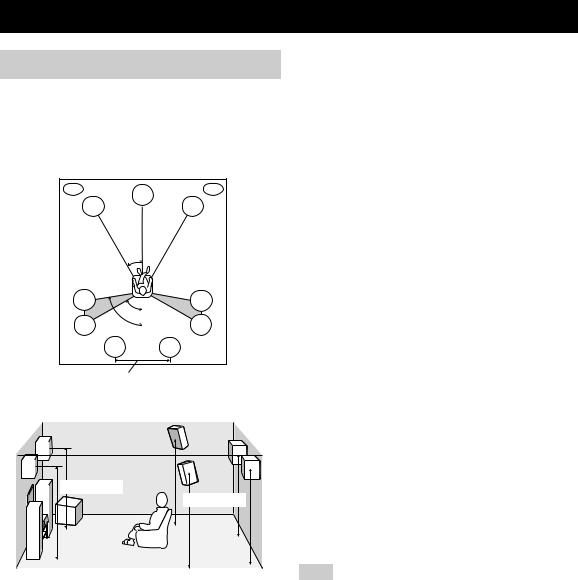
CONNECTIONS
Before connecting speakers
The speaker layout below shows the standard ITU-R* speaker setting. You can use it to enjoy CINEMA DSP, multi-channel audio sources and THX.
*ITU-R is the radio communication sector of the ITU (International Telecommunication Union).
PL |
PR |
|
C |
FL |
FR |
30˚
SL |
|
SR |
|
|
60˚ |
SL |
80˚ |
SR |
|
SBL |
SBR |
More than 30 cm (12 in)
1.8 m (6 ft) |
1.8 m (6 ft) |
Front speakers (FR and FL)
The front speakers are used for the main source sound plus effect sounds. Place these speakers an equal distance from the ideal listening position. The distance of each speaker from each side of the video monitor should be the same.
Center speaker (C)
The center speaker is for the center channel sounds (dialog, vocals, etc.). If for some reason it is not practical to use a center speaker, you can do without it. Best results, however, are obtained with the full system. Align the front face of the center speaker with the front face of your video monitor. Place the speaker centrally between the front speakers and as close to the monitor as possible, such as directly over or under it.
Surround speakers (SR and SL)
The surround speakers are used for effect and surround sounds. Place these speakers behind your listening position, facing slightly inwards, about 1.8 m (6 ft) above the floor.
Surround back speakers (SBR and SBL)
The surround back speakers supplement the surround speakers and provide for more realistic front-to-back transitions. Place these speakers directly behind the listening position and at the same height as the surround speakers. They should be positioned at least 30 cm (12 in) apart. Ideally, they should be positioned at the same width as the front speakers.
Subwoofer
The use of a subwoofer, such as the YAMAHA Active Servo Processing Subwoofer System, is effective not only for reinforcing bass frequencies from any or all channels, but also for high fidelity reproduction of the LFE (lowfrequency effect) channel included in Dolby Digital and DTS software. The position of the subwoofer is not so critical, because low bass sounds are not highly directional. But it is better to place the subwoofer near the front speakers. Turn it slightly toward the center of the room to reduce wall reflections.
Presence speakers (PR and PL)
Presence speakers supplement the sound from the front speakers with extra ambient effects produced by CINEMA DSP (see page 64). These effects include sounds that filmmakers intend to locate a little farther back behind the screen in order to create more theater-like ambience. Place these speakers at the front of the room about 0.5 – 1 m
(1 – 3 ft) outside the front speakers, facing slightly inwards, and about 1.8 m (6 ft) above the floor.
Note
Surround back and presence speakers do not output sound simultaneously. You can set to prioritize either set of speakers using the PRIORITY parameter in MANUAL SETUP (see page 79).
14
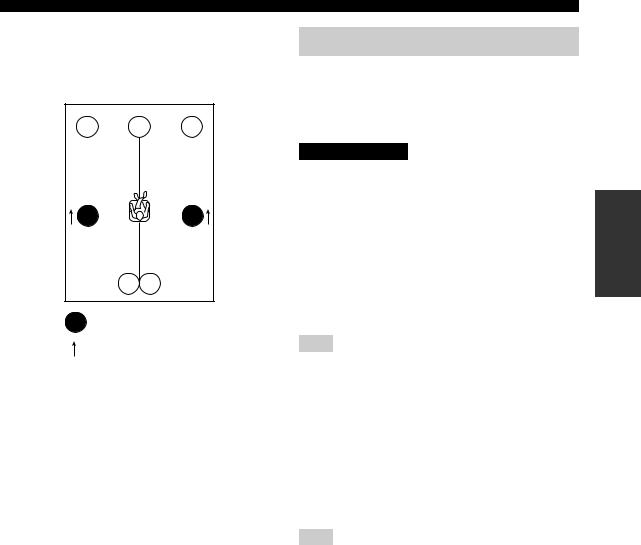
■ Di-pole speaker layout
Either di-pole or direct radiating speaker types can be used for THX surround. If you choose di-pole speakers, please place the surround and surround back speakers according to the speaker layout below.
FL |
C |
FR |
SL |
SR |
SBL SBR
: Di-pole speaker
: Direction of the di-pole speaker phase
CONNECTIONS
Connecting speakers
Be sure to connect the left channel (L), right channel (R), “+” (red) and “–” (black) properly. If the connections are faulty, no sound will be heard from the speakers, and if the polarity of the speaker connections is incorrect, the sound will be unnatural and lack bass.
CAUTION
•If you will use 6 ohm speakers, be sure to set this unit’s speaker impedance setting to 6 ohms before using (see page 31). If you will use 8 ohm speakers, use this unit’s initial setting for speaker impedance.
•Before connecting the speakers, make sure that this unit is disconnected from the power source.
•Do not let the bare speaker wires touch each other or do not let them touch any metal part of this unit. This could damage this unit and/or speakers.
•Use magnetically shielded speakers. If this type of speaker still creates interference with the monitor, place the speakers away from the monitor.
Note
A speaker cord is actually a pair of insulated cables running side by side. One cable is colored or shaped differently, perhaps with a stripe, groove or ridges. Connect the striped (grooved, etc.) cable to the “+” (red) terminals on this unit and your speaker. Connect the plain cable to the “–” (black) terminals.
■ Connecting to the speaker terminals
FRONT terminals
Connect one or two speaker systems to these terminals. If you use only one speaker system, connect it to either of the FRONT A or B terminals.
Note
The Canada model cannot output to two pairs of speaker systems simultaneously.
CENTER terminals
Connect a center speaker to these terminals.
SURROUND ZONE 2(3) terminals
Connect surround speakers to these terminals.
SUBWOOFER jack
Connect a subwoofer with a built-in amplifier, such as the YAMAHA Active Servo Processing Subwoofer System, to this jack.
SURROUND BACK terminals
Connect surround back speakers to these terminals.
If you only connect one surround back speaker, connect it to the left (L) terminals.
PREPARATION
15
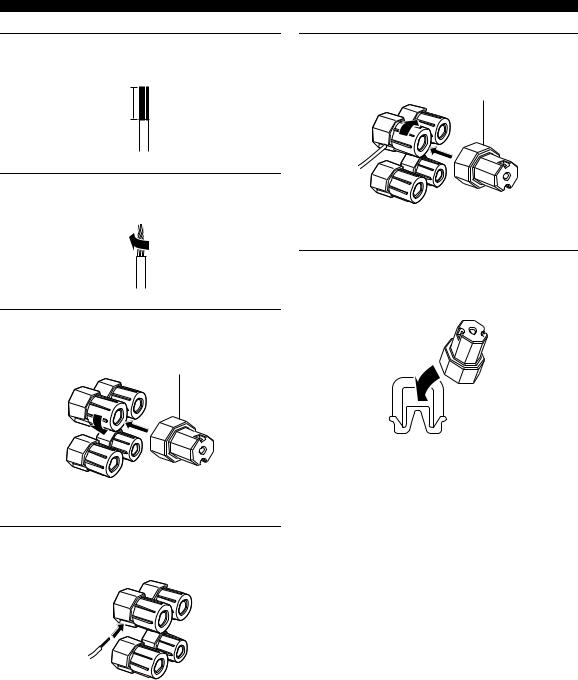
CONNECTIONS
1Remove approximately 10 mm (3/8 in) of insulation from each of the speaker cables.
10 mm (3/8 in)
2Twist the exposed wires of the cable together to prevent short circuits.
3Loosen the knob using the supplied speaker terminal wrench.
Speaker terminal wrench
Red: positive (+)
Black: negative (–)
4Insert one bare wire into the hole on the side of each terminal.
Red: positive (+)
Black: negative (–)
5Tighten the knob to secure the wire using the supplied speaker terminal wrench.
Speaker terminal wrench
Red: positive (+)
Black: negative (–)
6Hook the speaker terminal wrench onto WRENCH HOLDER on the rear panel of this unit when not in use.
16
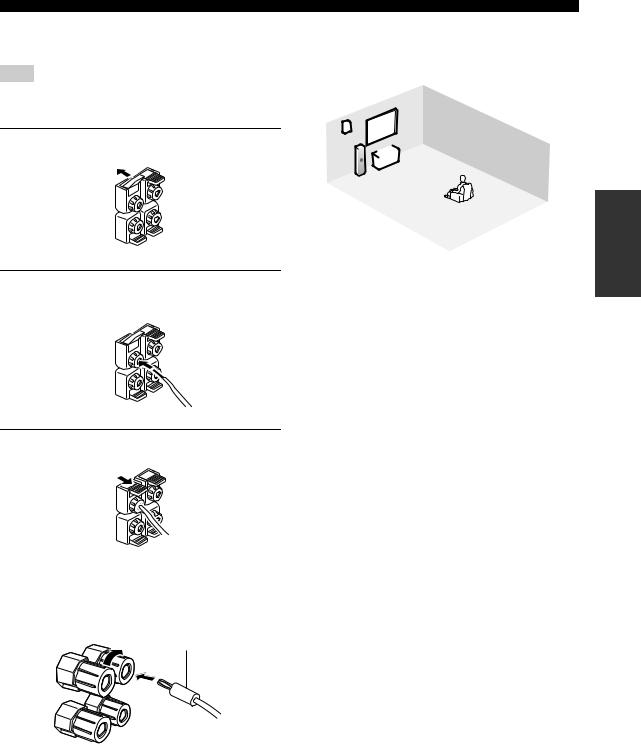
PRESENCE/ZONE 2(3) terminals
Connect presence speakers to these terminals.
Note
You can also use these terminals to connect the Zone 2 speakers (see page 105).
1 Open the tab.
2Insert one bare wire into the hole of each terminal.
3 Return the tab to secure the wire.
CONNECTIONS
■ Speaker layout
Refer to the following illustration as to where to place each speaker in your listening room.
|
9 |
|
|
10 |
2 |
|
|
4 |
|
|
|
|
1 |
7 |
|
|
|
||
3 |
|
|
|
|
|
|
|
|
8 |
|
5 |
|
|
6 |
|
|
|
|
1Subwoofer
2Front right speaker
3Front left speaker
4Center speaker
5Surround back right speaker
6Surround back left speaker
7Surround right speaker
8Surround left speaker
9Presence right speaker
10Presence left speaker
PREPARATION
■ Connecting the banana plug
(With the exception of U.K., Europe and Asia models) First, tighten the knob and then insert the banana plug connector into the end of the corresponding terminal.
Banana plug
(With the exception of U.K., Europe and Asia models)
y
You can also use banana plugs with the PRESENCE/ZONE 2(3) speaker terminals. Open the tab, then insert one banana plug connector into the hole of each terminal. Do not attempt to close the tabs after connecting the banana plugs.
17
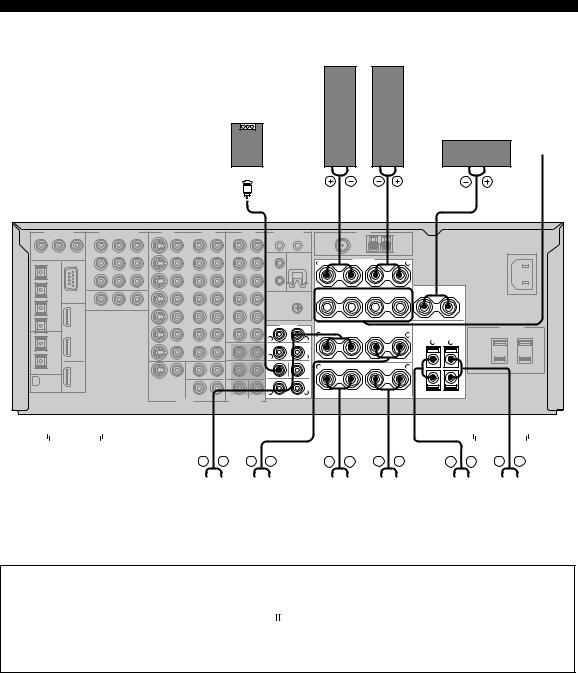
CONNECTIONS
|
Front speakers (A) |
|
|
|
Right |
Left |
|
Subwoofer with |
|
|
|
built-in amplifier |
|
Center |
Front |
|
|
speaker |
speakers |
|
|
|
(B) |
1 |
2 |
3 |
4 |
(U.S.A. model)
FRONT |
PRE OUT |
|
R |
|
L |
SURROUND |
|
|
R |
|
L |
SUBWOOFER |
CENTER |
|
|
|
SINGLE |
|
|
(SB) |
R |
|
L |
SURROUND BACK/PRESENCE |
||
|
+ |
– |
SPEAKERS |
– |
+ |
|
|
R |
A |
L |
|
||||
|
|
|
|
|
|||
FRONT |
|
B |
|
|
CENTER |
|
|
|
+ |
– |
– |
+ |
– |
+ |
|
|
|
|
|
|
|
SPEAKER IMPEDANCE |
|
R |
+ |
– |
|
– |
+ |
L |
|
|
|
|
|
|
|
R |
L |
|
|
|
|
|
|
+ |
|
R |
+ |
– |
|
– |
+ |
L |
|
|
|
|
|
|
|
||
|
|
|
|
|
|
– |
|
|
|
|
|
|
SINGLE |
|
|
|
|
SURROUND BACK |
|
PRESENCE/ZONE 2(3) |
|||
|
|
|
|
|
|
|
|
|
|
|
|
|
|
|
|
|
|
|
|
|
|
|
|
|
|
|
|
|
|
|
|
|
|
|
|
|
|
|
|
|
|
|
|
|
|
|
|
|
|
|
|
|
|
|
|
|
|
|
|
|
|
|
|
|
|
|
|
|
|
|
|
|
|
|
|
|
|
|
|
|
|
|
|
7 |
|
|
|
|
|
|
|
|
|
|
|
8 |
5 |
|
|
|
|
|
|
|
|
|
|
|
6 |
9 |
|
|
|
|
|
|
|
|
|
|
10 |
||||
|
|
|
|
|
|
|
|
|
|
|
|
|
|
|
|
|
|
|
|
|
|
|
|
|
|
|
|
|
|
|
|
||||||||||
|
|
|
|
|
|
|
|
|
|
|
|
|
|
|
|
|
|
|
|
|
|
||||||||||||||||||||
|
|
|
|
|
|
|
|
|
|
|
|
|
|
|
|
|
|
|
|
|
|
|
|
|
|
|
|
|
|
|
|
|
|
|
|
|
|||||
|
|
|
|
Right |
|
Left |
|
Right |
Left |
|
|
Right |
Left |
||||||||||||||||||||||||||||
|
|
|
Surround speakers |
Surround back speakers |
|
Presence speakers |
|||||||||||||||||||||||||||||||||||
•You can connect both surround back and presence speakers to this unit, but they do not output sound simultaneously. You can set to prioritize either set of speakers using the PRIORITY parameter in MANUAL SETUP (see page 79).
•The surround back speakers output the surround back channel included in Dolby Digital EX and DTS-ES software and operate
only when the Dolby Digital EX, DTS-ES, Dolby Pro Logic x, THX Select2, THX Music, THX Games or THX Surround EX decoder is turned on.
•The presence speakers output ambient effects created by the DSP sound fields. They do not output sound when other sound fields are selected.
18
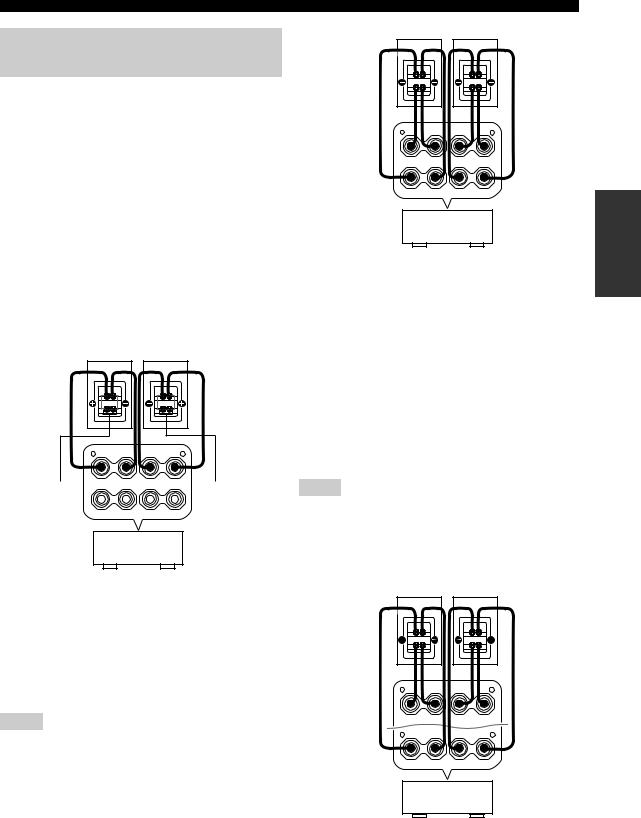
Using bi-wire and bi-AMP connections
Some of the speakers commercially available these days have speaker wire connections that allow bi-wiring or biamplification to enhance the performance of the speaker system. This unit allows you to make bi-wire and bi-AMP connections to one speaker system. Check if your speakers support bi-wiring or bi-amplification. As these speakers are shipped to you, you will note gold-plated shorting bars or bridges, one connecting the two red input terminals and the other connecting the two black input terminals. Remove these shorting bars or bridges only if you plan to bi-wire or bi-AMP your speakers.
■ Conventional connection
If you want to connect your speakers as traditional loudspeakers using the conventional connection method, connect your speakers using the regular left and right speaker wire connections and ignore the second set of terminals.
R + |
– |
A |
– |
+ |
L |
FRONT + |
– |
B |
– |
+ |
|
Shorting bars |
|
|
|
Shorting bars |
|
|
|
|
|
||
or bridges |
|
|
|
|
or bridges |
This unit
■ Bi-wire connection
The bi-wire connection separates the woofer from the combined midrange and tweeter section. A bi-wire compatible speaker has four binding post terminals. These two sets of terminals allow the speaker to be split into two independent sections. This split connects the mid and high frequency drivers to one set of terminals and the low frequency driver to the other pair.
Notes
•Remove the shorting bars or bridges to separate the LPF (low pass filter) and HPF (high pass filter) crossovers.
•To use the bi-wire connections, press SPEAKERS A on the front panel so that SP A lights up in the front panel display.
CONNECTIONS
R + |
– |
A |
– |
+ |
L |
FRONT + |
– |
B |
– |
+ |
|
|
|
|
|
|
This unit
■ Bi-AMP connection
The bi-AMP connection uses two amplifiers for both speakers. One amplifier is connected to the woofer section of a loudspeaker while the other is connected to the combined mid and tweeter section. With this arrangement each amplifier operates over a restricted frequency range. This restricted range presents each amplifier with a much simpler job and each amplifier is less likely to influence the sound in some way. The internal crossover of the speaker consists of a LPF (low pass filter) and a HPF (high pass filter). As its name implies, the LPF passes frequencies below a cutoff and rejects frequencies above the cutoff frequency. Likewise, the HPF passes frequencies above its cutoff.
Notes
•Remove the shorting bars or bridges to separate the LPF (low pass filter) and HPF (high pass filter) crossovers.
•To activate the bi-AMP connections, set BI-AMP to ON in ADVANCED SETUP (see page 91).
•To make the bi-AMP connections, use the FRONT and SURROUND BACK terminals as shown below.
R + |
– A – |
+ L |
FRONT
R + |
– |
– |
+ L |
SINGLE
SURROUND BACK
This unit
PREPARATION
19
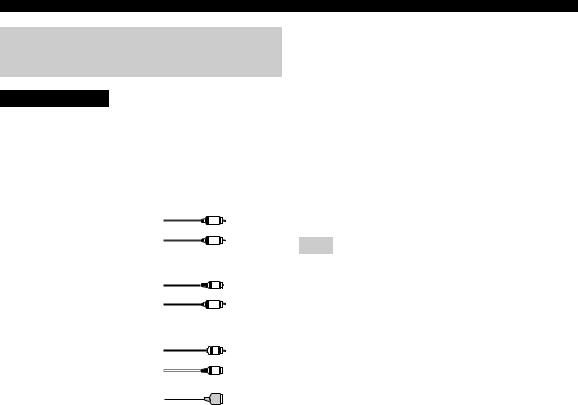
CONNECTIONS
Information on cables and jacks used for connections
CAUTION
Do not connect this unit or other components to the main power until all connections between components are complete.
■ Cable indications
For analog signals
left analog cables |
L |
right analog cables |
R |
|
|
For digital signals |
|
optical cables |
O |
|
|
coaxial cables |
C |
|
|
For video signals |
|
video cables |
V |
|
|
S-video cables |
S |
|
|
For HDMI signals |
|
■ Analog jacks
You can input analog signals from audio components by connecting audio pin cables to the analog jacks on this unit. Connect red plugs to the right jacks and white plugs to the left jacks.
■ Digital jacks
This unit has digital jacks for direct transmission of digital signals through either coaxial or fiber optic cables. You can use the digital jacks to input PCM, Dolby Digital and DTS bitstreams. When you connect components to both the COAXIAL and OPTICAL jacks, priority is given to signals input at the COAXIAL jack. All digital input jacks are compatible with 96-kHz sampling digital signals.
Note
This unit handles digital and analog signals independently. Thus audio signals input at the analog jacks are only output at the analog OUT (REC) jacks. Likewise, audio signals input at the digital (OPTICAL or COAXIAL) jacks are only output at the DIGITAL OUTPUT jacks.
20
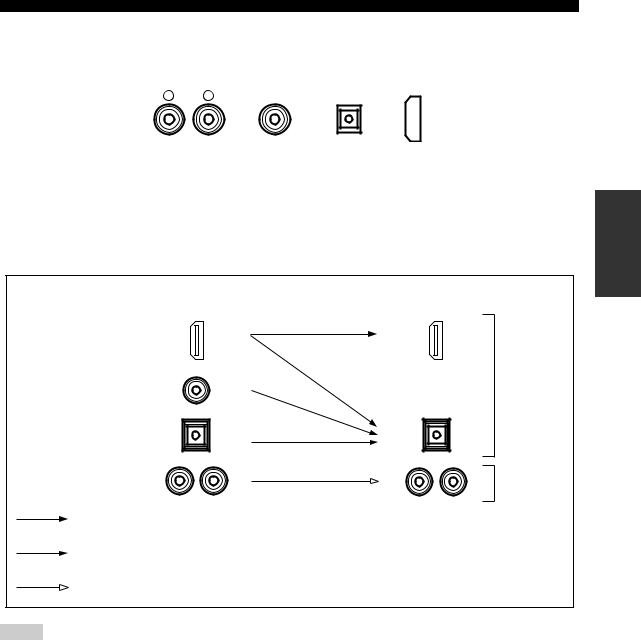
CONNECTIONS
■ Audio jacks
This unit has four types of audio jacks (analog audio, digital audio coaxial, digital audio optical and HDMI). Connection depends on the availability of audio jacks on your other components.
|
AUDIO |
DIGITAL AUDIO |
DIGITAL AUDIO |
HDMI |
||||
R |
L |
(COAXIAL) |
(OPTICAL) |
|
|
|
||
|
|
|
|
|
|
|
|
|
|
|
|
|
|
|
|
|
|
|
|
|
|
|
|
|
|
|
AUDIO jacks |
DIGITAL AUDIO (OPTICAL) jacks |
For conventional analog audio signals. |
For digital audio signals transmitted via digital optical |
DIGITAL AUDIO (COAXIAL) jacks |
cables. |
|
|
For digital audio signals transmitted via digital coaxial |
HDMI jacks |
cables. |
For HDMI digital audio signals. |
■ Audio signal flow for OUT (REC) |
|
Input |
Output |
OUT (REC) |
|
HDMI |
|
DIGITAL AUDIO |
Digital audio |
(COAXIAL) |
|
DIGITAL AUDIO |
|
(OPTICAL) |
|
AUDIO |
Analog audio |
Through
Digital output
Analog output
Notes
•The audio signals input at the HDMI IN 1 or HDMI IN 2 jack are output at the DIGITAL OUTPUT jacks only and are not output at the analog OUT (REC) jacks.
•2-channel as well as multi-channel PCM, Dolby Digital and DTS signals input at the HDMI IN 1 or HDMI IN 2 jack can be output at the HDMI OUT jack only when HDMI SET is set to OTHER (see page 82).
•2-channel PCM, Dolby Digital and DTS signals except multi-channel PCM signals input at the HDMI IN 1 or HDMI IN 2 jack can be output at the DIGITAL AUDIO (OPTICAL) jacks.
•Copy-protected 2-channel PCM signals with over 48 kHz/16 bit input at the HDMI IN 1 or HDMI IN 2 jack are not output at the DIGITAL AUDIO (OPTICAL) jacks.
PREPARATION
21
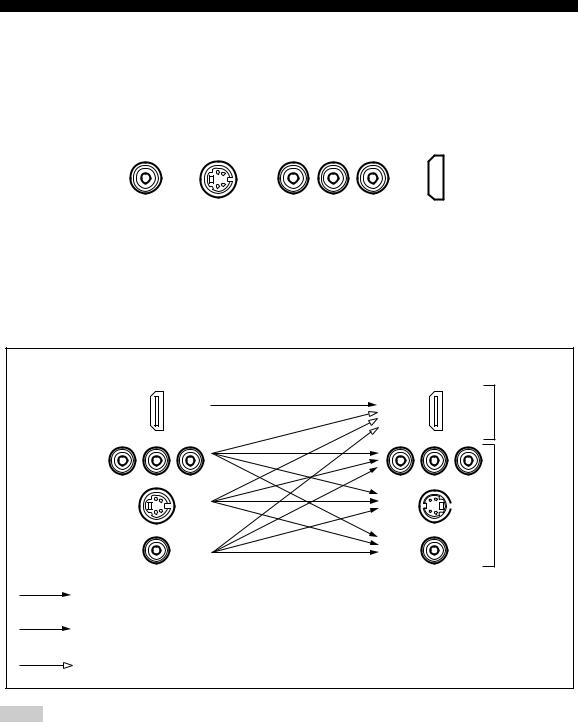
CONNECTIONS
■ Video jacks
This unit has four types of video jacks (composite, component, S-video and HDMI). Connection depends on the availability of input jacks on your monitor. When V CONV. is set to ON (see page 85), the analog video signals input at the VIDEO, S VIDEO and COMPONENT VIDEO jacks can be output at the VIDEO, S VIDEO and COMPONENT VIDEO jacks interchangeably. In addition, when V CONV. is set to ON (see page 85) and HDMI I/P is set to ON (see page 86), the analog video signals input at the VIDEO, S VIDEO and COMPONENT VIDEO jacks can be digitally upconverted and output at the HDMI OUT jack.
|
|
COMPONENT VIDEO |
||||
VIDEO |
S VIDEO |
Y |
PB |
HDMI |
||
PR |
||||||
|
|
|
|
|
|
|
VIDEO jacks
For conventional composite video signals.
S VIDEO jacks
For S-video signals, separated into luminance (Y) and color (C) video signals to achieve high-quality color reproduction.
■ Video signal flow for MONITOR OUT
COMPONENT VIDEO jacks
For component signals, separated into luminance (Y) and color difference (PB, PR) to provide the best quality in picture reproduction.
HDMI jacks
For HDMI digital video signals.
HDMI
COMPONENT VIDEO
Input |
Output |
(MONITOR OUT) |
Digital video
S VIDEO |
Analog video |
VIDEO
Through
Component interlace/progressive conversion (see page 85)
HDMI interlace/progressive up-conversion (see page 86)
Notes
•The analog video signals output at the COMPONENT VIDEO jacks can be deinterlaced from 480i to 480p. Set CMPNT I/P to ON in MANUAL SETUP to activate this feature (see page 85).
•The analog video signals input at the COMPONENT VIDEO jacks and output at the S VIDEO or VIDEO jacks cannot be converted to 480p/1080i/720p.
•When the analog video signals are input at the COMPONENT VIDEO, S VIDEO and VIDEO jacks, the priority order of the input signals is as follows where the analog video signals input at the COMPONENT VIDEO jacks have the top priority.
1.COMPONENT VIDEO
2.S VIDEO
3.VIDEO
•Component interlace/progressive conversion (see page 85) and HDMI interlace/progressive up-conversion (see page 86) are available only when V CONV. is set to ON (see page 85).
22
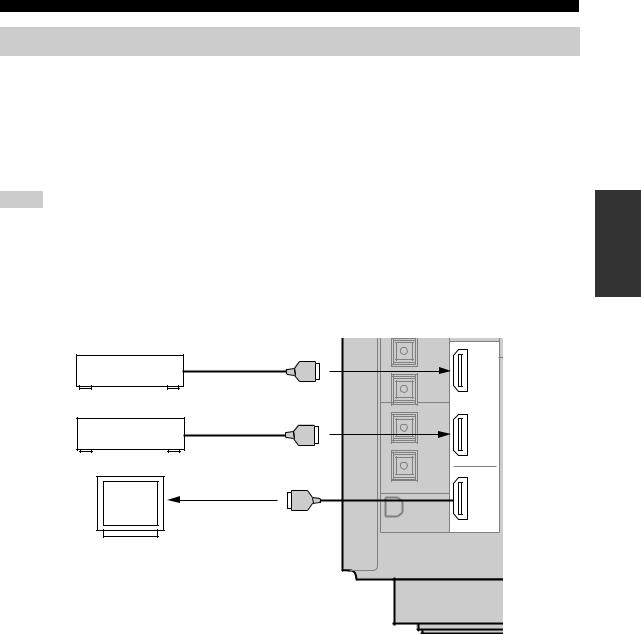
CONNECTIONS
Connecting HDMI components
This unit has the HDMI IN 1 and HDMI IN 2 jacks for digital audio and video signal input as well as the HDMI OUT jack for digital audio and video signal output. Connect the HDMI IN 1 or HDMI IN 2 jack of this unit to the HDMI OUT jack of other HDMI components (such as a DVD player). Connect the HDMI OUT jack of this unit to the HDMI IN jack of other HDMI components (such as a TV and a projector).
The video or audio signals input at the HDMI IN 1 or HDMI IN 2 jack you selected using the HDMI IN menu in I/O ASSIGNMENT (see page 83) or the INPUT selector on the front panel are output at the HDMI OUT jack of this unit. In addition, the audio signals input at the HDMI IN 1 or HDMI IN 2 jack are output to speakers, headphones and the DIGITAL OUTPUT jacks.
Notes
•We recommend using an HDMI cable shorter than 5 meters (16 feet) with the HDMI logo printed on it.
•Digital audio signals input at the HDMI IN jacks are not output at the analog AUDIO OUT jacks.
•Some audio signals may not be output at the DIGITAL OUTPUT jacks depending on the signal type.
•The analog video signals input at the composite video, S-video and component video jacks can be digitally up-converted to be output at the HDMI OUT jack. Set HDMI I/P to ON in MANUAL SETUP to activate this feature (see page 86).
•Some video monitors connected to this unit via a DVI connection fail to recognize the HDMI audio signals being input if they are in the standby mode. In this case, the HDMI indicator flashes irregularly and HDCP ERROR appears in the front panel display as if the DVI monitors do not support the HDCP copy protection standards.
|
IN 1 |
DVD Player |
HDMI out |
|
|
|
IN 2 |
Cable TV or |
HDMI out |
Satellite tuner |
|
|
OUT |
Video |
HDMI in |
|
|
monitor |
|
|
HDMI |
PREPARATION
(U.S.A. model)
23
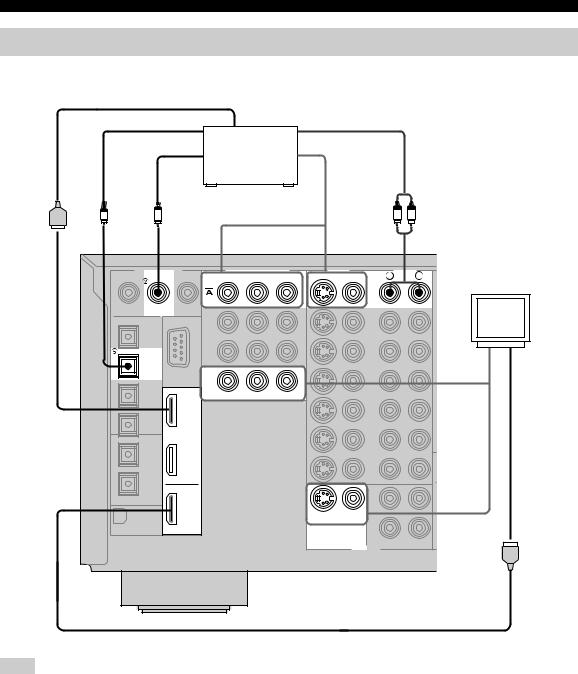
CONNECTIONS
Connecting video components
■ Connecting a DVD player
HDMI out |
|
Optical out |
Audio out |
Coaxial out |
Video out |
|
DVD player |
O |
C |
|
|
|
|
|
R |
L |
|
|
DIGITAL INPUT |
COMPONENT VIDEO |
VIDEO |
AUDIO |
|
||||
|
COAXIAL |
Y |
PB |
PR |
S VIDEO |
VIDEO |
R |
L |
|
|
|
DVD |
|
|
|
|
|
|
|
|
|
|
|
|
|
DVD |
|
|
|
|
DVD |
|
|
|
|
|
|
|
Video |
|
|
|
|
|
|
|
|
|
|
|
OPTICAL |
|
|
|
|
|
|
|
monitor |
|
|
|
|
|
|
|
|
|
|
|
DVD |
|
|
|
|
|
|
|
|
|
|
|
|
|
|
|
|
Video in |
HDMI in |
|
IN 1 |
|
MONITOR OUT |
|
|
|
|
|
|
|
IN 2 |
|
|
|
|
|
|
|
|
|
OUT |
|
|
|
|
|
|
|
|
|
DIGITAL OUTPUT |
|
|
|
|
|
|
|
|
|
|
|
|
|
MONITOR OUT |
|
|
|
|
|
HDMI |
|
|
|
|
|
|
|
|
|
|
|
|
|
|
OUTPUT |
|
|
|
(U.S.A. model)
Note
Check the availability of jacks on your DVD player and select one type of connection for audio/video input/output. However, in case you make an HDMI connection, you can make both audio and video connections using a single HDMI cable.
24
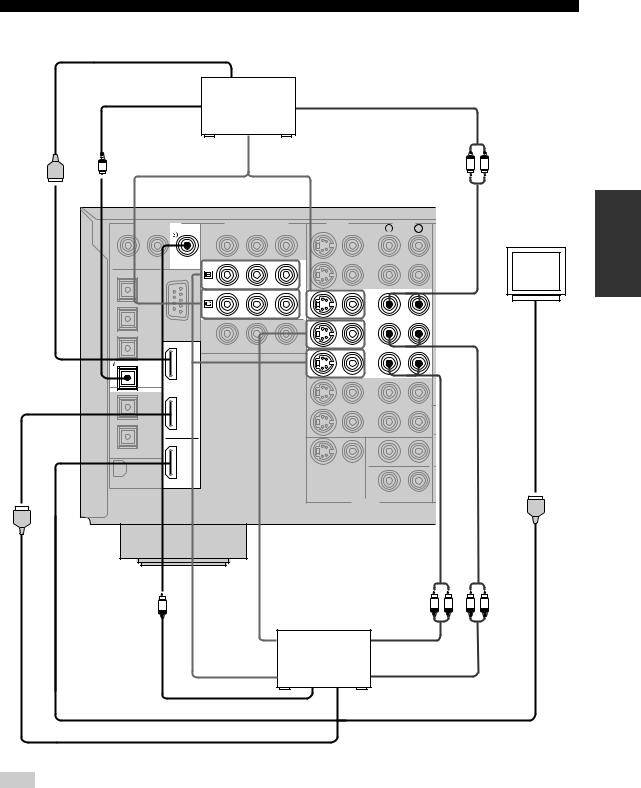
CONNECTIONS
■ Connecting other video components
HDMI out |
|
|
Optical out |
Cable TV or |
Audio out |
|
|
|
|
satellite tuner |
|
|
Video out |
|
O |
|
R L |
|
|
|
|
|
(U.S.A. model) |
DIGITAL INPUT |
COMPONENT VIDEO |
VIDEO |
|
AUDIO |
|||
COAXIAL |
Y |
PB |
PR |
S VIDEO |
VIDEO |
R |
L |
VCR 2 |
|
|
|
|
|
|
Video |
DVR/ |
|
|
|
|
|
|
|
|
DTV |
|
|
|
|
|
monitor |
OPTICAL |
|
|
|
|
|
|
|
|
CBL/ |
|
|
|
|
|
|
|
SAT |
|
|
|
|
CBL/ |
|
|
|
|
|
|
|
|
|
|
|
|
|
|
|
SAT |
|
|
|
|
|
|
|
IN |
|
IN 1 |
|
|
|
|
|
VCR 1 |
|
CBL/SAT |
|
|
|
|
|
OUT |
|
IN 2 |
|
|
|
|
|
|
|
OUT |
|
|
|
|
|
|
|
DIGITAL OUTPUT |
|
|
|
|
|
|
|
HDMI |
|
|
|
|
|
|
|
PREPARATION
C |
|
R L |
R L |
|
|
Audio in |
|
Video out |
DVD recorder |
|
|
|
|
|
|
Video out |
or VCR |
Audio out |
|
|
|
||
Coaxial out |
|
|
|
HDMI in
HDMI out
Note
Check the availability of jacks on your other video components and select one type of connection for audio/video input/output. However, in case you make an HDMI connection, you can make both audio and video connections using a single HDMI cable.
25
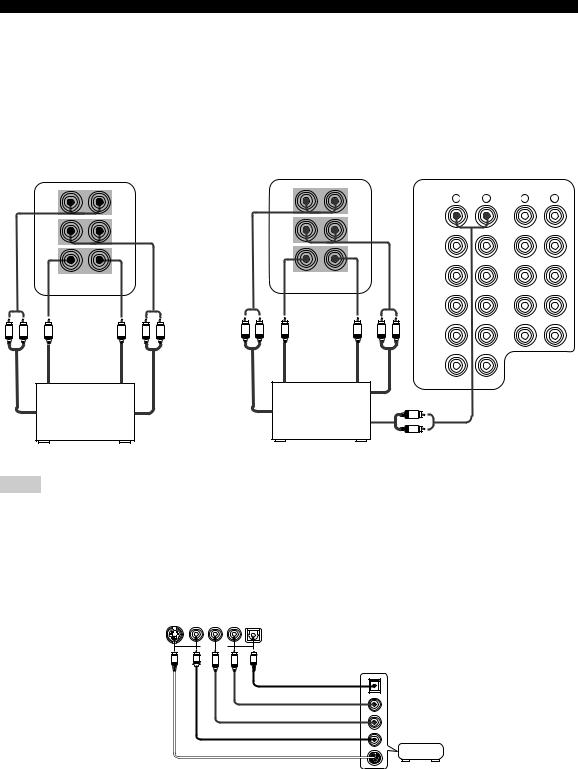
CONNECTIONS
■ Connecting to the MULTI CH INPUT jacks
This unit is equipped with 6 additional input jacks (left and right FRONT, CENTER, left and right SURROUND and SUBWOOFER) for discrete multi-channel input from a multi-format player, external decoder, sound processor or pre-amplifier.
If you set INPUT CH to 8ch in MULTI CH SET (see page 84), you can use the input jacks assigned as FRONT in MULTI CH SET (see page 84) together with the MULTI CH INPUT jacks to input 8-channel signals.
Connect the output jacks on your multi-format player or external decoder to the MULTI CH INPUT jacks. Be sure to match the left and right outputs to the left and right input jacks for the front and surround channels.
|
For 6-channel input |
|
|
For 8-channel input |
|
|
|
|
|
FRONT(6CH)/SB(8CH) |
|
|
FRONT(6CH)/SB(8CH) |
|
AUDIO |
|
AUDIO |
|
|
|
|
|
R |
L |
R |
L |
|
|
|
|
|
|
|
(PLAY) |
|
|
|
|
|
|
DVD |
|
IN |
|
|
SURROUND |
|
|
SURROUND |
|
|
|
|
|
|
|
|
|
|
|
||
|
|
|
|
|
|
|
MD/TAPE |
|
|
|
|
|
|
DTV |
|
OUT |
|
|
|
|
|
|
|
|
|
|
|
|
|
|
|
|
|
(REC) |
|
|
|
|
|
|
|
|
(PLAY) |
|
|
|
|
|
SUBWOOFER CENTER |
CBL/ |
|
IN |
|
|
SUBWOOFER CENTER |
|
|
|
|
|
||
|
|
|
SAT |
|
|
|
||
|
|
|
|
|
|
|
||
|
MULTI CH INPUT |
|
|
MULTI CH INPUT |
|
|
CD-R |
|
|
|
|
|
|
|
|
||
|
|
|
|
|
|
|
|
|
|
|
|
|
|
IN |
|
OUT |
|
|
|
|
|
|
|
|
|
|
|
|
|
|
|
VCR 1 |
|
(REC) |
|
|
Subwoofer |
|
|
Subwoofer |
|
|
|
|
R L |
R L |
R L |
R L |
|
|
|
||
|
out |
|
|
out |
OUT |
|
CD |
|
|
|
|
|
|
|
|
||
|
Center |
|
|
Center |
IN |
|
|
|
|
out |
|
|
out |
DVR/VCR 2 |
|
|
|
|
|
|
|
|
|
|
|
|
|
Multi-format player/ |
|
|
Multi-format player/ |
Surround out |
|
|
|
Front |
External decoder |
Surround |
Surround |
External decoder |
R |
|
|
|
|
|
L |
|
|
|
|||
out |
|
out |
back out |
|
|
|
|
|
|
|
Front out |
|
|
|
|||
|
|
|
|
|
|
|
|
|
Notes
•When you select MULTI CH INPUT as the input source, this unit automatically turns off the digital sound field processor, and you cannot select sound field programs.
•This unit does not redirect signals input at the MULTI CH INPUT jacks to accommodate for missing speakers. We recommend that you connect at least a 5.1-channel speaker system before using this feature.
•When headphones are used, only front L/R channels are output.
■ Connecting to the VIDEO AUX jacks on the front panel
Use these jacks to connect any video source, such as a game console or video camera, to this unit.
S VIDEO VIDEO L AUDIO R OPTICAL
VIDEO/AUX
S |
V |
L |
R |
O |
Optical out |
|
Audio out R |
|
Audio out L |
Game |
Video out |
console or |
video camera |
|
S-video out |
|
26
